Go Math Grade 5 Answer Key Chapter 6 Add and Subtract Fractions with Unlike Denominators can be downloaded free of cost from here. HMH Go Math Grade 5 Answer Key includes topics such as Addition and Subtraction with unlike denominators, Estimate fraction sums and differences, Least Common Denominators, etc. Begin your preparation from Go Math Grade 5 Chapter 6 Solution Key Add and Subtract Fractions with Unlike Denominators and score better grades in your exams.
Go Math Grade 5 Answer Key Chapter 6 Add and Subtract Fractions with Unlike Denominators
The Go Math Grade 5 Answer Key Add and Subtract Fractions with Unlike Denominators covers all the Questions in Chapter Tests, Practice Tests, etc., and has detailed solutions for all of them. Try to solve as many problems as possible from the Go Math Answer Key for Grade 5 Chapter 6 Add and Subtract Fractions with Unlike Denominators and know the concepts behind them easily. Access the Topics in 5th Grade Go Math Ch 6 Add and Subtract Fractions with Unlike Denominators via quick links available in the forthcoming modules.
Lesson 1: Investigate • Addition with Unlike Denominators
- Share and Show – Page No. 244
- Investigate • Addition with Unlike Denominators Page No. 245
- Problem Solving – Page No. 246
Lesson 2: Investigate • Subtraction with Unlike Denominators
- Share and Show – Page No. 248
- Investigate • Subtraction with Unlike Denominators Page No. 249
- UNLOCK the Problem – Page No. 250
Lesson 3: Estimate Fraction Sums and Differences
Lesson 4: Common Denominators and Equivalent Fractions
- Share and Show – Page No. 256
- Common Denominators and Equivalent Fractions Page No. 257
- UNLOCK the Problem – Page No. 258
Lesson 5: Add and Subtract Fractions
Mid-Chapter Checkpoint
Lesson 6: Add and Subtract Mixed Numbers
Lesson 7: Subtraction with Renaming
- Share and Show – Page No. 270
- Subtraction with Renaming Page No. 271
- Subtraction with Renaming Page No. 272
Lesson 8: Algebra • Patterns with Fractions
Lesson 9: Problem Solving • Practice Addition and Subtraction
Lesson 10: Algebra • Use Properties of Addition
Chapter 6 Review/Test
- Chapter Review/Test – Vocabulary – Page No. 285
- Chapter Review/Test – Page No. 286
- Chapter Review/Test – Page No. 287
- Chapter Review/Test – Page No. 288
Share and Show – Page No. 244
Use fraction strips to find the sum. Write your answer in simplest form.
Question 1.

\(\frac{1}{2}+\frac{3}{8}=\)
\(\frac{□}{□}\)
Answer: \(\frac{7}{8}\)
Explanation:
Step 1:
Place three \(\frac{1}{8}\) fractions strips under the 1 whole strip on your Mathboard. Then place a \(\frac{1}{2}\) fraction strip beside the three \(\frac{1}{8}\) strips.
Step 2:
Find fraction strips, all with the same denominator, that are equivalent to \(\frac{1}{2}\) and \(\frac{3}{8}\). Place the fraction strips under the sum. At the right, draw a picture of the model and write the equivalent fractions.
\(\frac{1}{2}\) = \(\frac{1}{2}\) × \(\frac{4}{4}\) = \(\frac{4}{8}\)
\(\frac{3}{8}\)
Step 3:
Add the fractions with like denominators. Use the 1 whole strip to rename the sum in the simplest form.
\(\frac{4}{8}\) + \(\frac{3}{8}\) = \(\frac{7}{8}\)
Question 2.

\(\frac{1}{2}+\frac{2}{5}=\)
\(\frac{□}{□}\)
Answer: \(\frac{9}{10}\)
Explanation:
Step 1:
Place two \(\frac{1}{5}\) fractions strips under the 1 whole strip on your Mathboard. Then place a \(\frac{1}{2}\) fraction strip beside the two \(\frac{1}{5}\) strips.
Step 2:
Find fraction strips, all with the same denominator, that are equivalent to \(\frac{1}{2}\) and \(\frac{2}{5}\). Place the fraction strips under the sum. At the right, draw a picture of the model and write the equivalent fractions.
\(\frac{1}{2}\) = \(\frac{1}{2}\) × \(\frac{5}{5}\) = \(\frac{5}{10}\)
\(\frac{2}{5}\) = \(\frac{2}{5}\) × \(\frac{2}{2}\) = \(\frac{4}{10}\)
Step 3:
Add the fractions with like denominators. Use the 1 whole strip to rename the sum in the simplest form.
\(\frac{5}{10}\) + \(\frac{4}{10}\) = \(\frac{9}{10}\)
Thus, \(\frac{1}{2}\) + \(\frac{2}{5}\) = \(\frac{9}{10}\)
Page No. 245
Use fraction strips to find the sum. Write your answer in simplest form.
Question 3.

\(\frac{3}{8}+\frac{1}{4}=\)
\(\frac{□}{□}\)
Answer: \(\frac{5}{8}\)
Explanation:
Step 1:
Place three \(\frac{1}{8}\) fractions strips under the 1 whole strip on your Mathboard. Then place a \(\frac{1}{4}\) fraction strip beside the three \(\frac{1}{8}\) strips.
Step 2:
Find fraction strips, all with the same denominator, that are equivalent to \(\frac{1}{4}\) and \(\frac{3}{8}\). Place the fraction strips under the sum. At the right, draw a picture of the model and write the equivalent fractions.
\(\frac{1}{4}\) × \(\frac{2}{2}\) = \(\frac{2}{8}\)
Step 3:
Add the fractions with like denominators. Use the 1 whole strip to rename the sum in the simplest form.
\(\frac{2}{8}\) + \(\frac{3}{8}\) = \(\frac{5}{8}\)
Question 4.

\(\frac{3}{4}+\frac{1}{3}=\)
______ \(\frac{□}{□}\)
Answer: 1 \(\frac{1}{12}\)
Explanation:
Step 1:
Place three \(\frac{3}{4}\) fractions strips under the 1 whole strip on your Mathboard. Then place a \(\frac{1}{3}\) fraction strip beside the three \(\frac{1}{4}\) strips.
Step 2:
Find fraction strips, all with the same denominator, that are equivalent to \(\frac{1}{3}\) and \(\frac{3}{4}\). Place the fraction strips under the sum. At the right, draw a picture of the model and write the equivalent fractions.
\(\frac{1}{3}\) × \(\frac{4}{4}\) = \(\frac{4}{12}\)
\(\frac{3}{4}\) × \(\frac{3}{3}\) = \(\frac{9}{12}\)
Step 3:
Add the fractions with like denominators. Use the 1 whole strip to rename the sum in the simplest form.
\(\frac{4}{12}\) + \(\frac{9}{12}\) = \(\frac{13}{12}\) = 1 \(\frac{1}{12}\)
Use fraction strips to find the sum. Write your answer in simplest form.
Question 5.
\(\frac{2}{5}+\frac{3}{10}=\)
\(\frac{□}{□}\)
Answer: \(\frac{7}{10}\)
Explanation:
Step 1:
Place three \(\frac{1}{10}\) fractions strips under the 1 whole strip on your Mathboard. Then place a two \(\frac{2}{5}\) fraction strip beside the three \(\frac{1}{10}\) strips.
Step 2:
Find fraction strips, all with the same denominator, that are equivalent to \(\frac{2}{5}\) and \(\frac{3}{10}\). Place the fraction strips under the sum. At the right, draw a picture of the model and write the equivalent fractions.
\(\frac{2}{5}\) • \(\frac{2}{2}\) = \(\frac{4}{10}\)
Step 3:
Add the fractions with like denominators. Use the 1 whole strip to rename the sum in the simplest form.
\(\frac{4}{10}\) + \(\frac{3}{10}\) = \(\frac{7}{10}\)
Question 6.
\(\frac{1}{4}+\frac{1}{12}=\)
\(\frac{□}{□}\)
Answer: \(\frac{4}{12}\)
Explanation:
Step 1:
Place \(\frac{1}{12}\) fractions strips under the 1 whole strip on your Mathboard. Then place a \(\frac{1}{4}\) fraction strip beside the \(\frac{1}{12}\) strips.
Step 2:
Find fraction strips, all with the same denominator, that are equivalent to \(\frac{1}{12}\) and \(\frac{1}{4}\). Place the fraction strips under the sum. At the right, draw a picture of the model and write the equivalent fractions.
\(\frac{1}{4}\) • \(\frac{3}{3}\) = \(\frac{3}{12}\)
\(\frac{1}{12}\)
Step 3:
Add the fractions with like denominators. Use the 1 whole strip to rename the sum in the simplest form.
\(\frac{3}{12}\) + \(\frac{1}{12}\) = \(\frac{4}{12}\)
Question 7.
\(\frac{1}{2}+\frac{3}{10}=\)
\(\frac{□}{□}\)
Answer: \(\frac{8}{10}\)
Explanation:
Step 1:
Place three \(\frac{1}{10}\) fractions strips under the 1 whole strip on your Mathboard. Then place a \(\frac{1}{2}\) fraction strip beside the three \(\frac{1}{10}\) strips.
Step 2:
Find fraction strips, all with the same denominator, that are equivalent to \(\frac{1}{2}\) and \(\frac{3}{10}\). Place the fraction strips under the sum. At the right, draw a picture of the model and write the equivalent fractions.
\(\frac{1}{2}\) • \(\frac{5}{5}\) = \(\frac{5}{10}\)
Step 3:
Add the fractions with like denominators. Use the 1 whole strip to rename the sum in the simplest form.
\(\frac{5}{10}\) + \(\frac{3}{10}\) = \(\frac{8}{10}\)
Question 8.
\(\frac{2}{3}+\frac{1}{6}=\)
\(\frac{□}{□}\)
Answer: \(\frac{5}{6}\)
Explanation:
Step 1:
Place two \(\frac{1}{3}\) fractions strips under the 1 whole strip on your Mathboard. Then place a \(\frac{1}{6}\) fraction strip beside the two \(\frac{1}{3}\) strips.
Step 2:
Find fraction strips, all with the same denominator, that are equivalent to \(\frac{1}{6}\) and \(\frac{2}{3}\). Place the fraction strips under the sum. At the right, draw a picture of the model and write the equivalent fractions.
\(\frac{2}{3}\) = \(\frac{2}{3}\) • \(\frac{2}{2}\) = \(\frac{4}{6}\)
Step 3:
Add the fractions with like denominators. Use the 1 whole strip to rename the sum in the simplest form.
\(\frac{4}{6}\) + \(\frac{1}{6}\) = \(\frac{5}{6}\)
Question 9.
\(\frac{5}{8}+\frac{1}{4}=\)
\(\frac{□}{□}\)
Answer: \(\frac{7}{8}\)
Explanation:
Step 1:
Place five \(\frac{1}{8}\) fractions strips under the 1 whole strip on your Mathboard. Then place a \(\frac{1}{4}\) fraction strip beside the five \(\frac{1}{8}\) strips.
Step 2:
Find fraction strips, all with the same denominator, that are equivalent to \(\frac{1}{4}\) and \(\frac{5}{8}\). Place the fraction strips under the sum. At the right, draw a picture of the model and write the equivalent fractions.
\(\frac{1}{4}\) • \(\frac{2}{2}\) = \(\frac{2}{8}\)
Step 3:
Add the fractions with like denominators. Use the 1 whole strip to rename the sum in the simplest form.
\(\frac{2}{8}\) + \(\frac{5}{8}\) = \(\frac{7}{8}\)
Question 10.
\(\frac{1}{2}+\frac{1}{5}=\)
\(\frac{□}{□}\)
Answer: \(\frac{7}{10}\)
Explanation:
Find fraction strips, all with the same denominator, that are equivalent to \(\frac{1}{5}\) and \(\frac{1}{2}\). Place the fraction strips under the sum. At the right, draw a picture of the model and write the equivalent fractions.
\(\frac{1}{5}\) • \(\frac{2}{2}\) = \(\frac{2}{10}\)
\(\frac{1}{2}\) • \(\frac{5}{5}\) = \(\frac{5}{10}\)
Add the fractions with like denominators. Use the 1 whole strip to rename the sum in the simplest form.
\(\frac{2}{10}\) + \(\frac{5}{10}\) = \(\frac{7}{10}\)
Question 11.
\(\frac{3}{4}+\frac{1}{6}=\)
\(\frac{□}{□}\)
Answer: \(\frac{11}{12}\)
Explanation:
Find fraction strips, all with the same denominator, that are equivalent to \(\frac{3}{4}\) and \(\frac{1}{6}\). Place the fraction strips under the sum. At the right, draw a picture of the model and write the equivalent fractions.
\(\frac{3}{4}\) • \(\frac{3}{3}\) = \(\frac{9}{12}\)
\(\frac{1}{6}\) • \(\frac{2}{2}\) = \(\frac{2}{12}\)
Add the fractions with like denominators. Use the 1 whole strip to rename the sum in the simplest form.
\(\frac{9}{12}\) + \(\frac{2}{12}\) = \(\frac{11}{12}\)
Question 12.
\(\frac{1}{2}+\frac{2}{3}=\)
______ \(\frac{□}{□}\)
Answer: 1 \(\frac{1}{6}\)
Explanation:
Find fraction strips, all with the same denominator, that are equivalent to \(\frac{2}{3}\) and \(\frac{1}{2}\). Place the fraction strips under the sum. At the right, draw a picture of the model and write the equivalent fractions.
\(\frac{2}{3}\) • \(\frac{2}{2}\) = \(\frac{4}{6}\)
\(\frac{1}{2}\) • \(\frac{3}{3}\) = \(\frac{3}{6}\)
Add the fractions with like denominators. Use the 1 whole strip to rename the sum in the simplest form.
\(\frac{4}{6}\) + \(\frac{3}{6}\) = \(\frac{7}{6}\)
\(\frac{7}{6}\) is greater than 1.
Convert the fraction into the mixed fraction
\(\frac{7}{6}\) = 1 \(\frac{1}{6}\)
Question 13.
\(\frac{7}{8}+\frac{1}{4}=\)
______ \(\frac{□}{□}\)
Answer: 1 \(\frac{1}{8}\)
Explanation:
Find fraction strips, all with the same denominator, that are equivalent to \(\frac{7}{8}\) and \(\frac{1}{4}\). Place the fraction strips under the sum. At the right, draw a picture of the model and write the equivalent fractions.
\(\frac{1}{4}\) • \(\frac{2}{2}\) = \(\frac{2}{8}\)
Add the fractions with like denominators. Use the 1 whole strip to rename the sum in the simplest form.
\(\frac{7}{8}\) + \(\frac{2}{8}\) = \(\frac{9}{8}\)
Convert \(\frac{9}{8}\) into the mixed fraction.
\(\frac{9}{8}\) = 1 \(\frac{1}{8}\)
Question 14.
Explain how using fraction strips with like denominators makes it possible to add fractions with unlike denominators.
Type below:
_________
Answer: The strips for both fractions need to be the same size. Finding like denominators is done by trying smaller strips so they can all be the same size.
Problem Solving – Page No. 246
Question 15.
Maya makes trail mix by combining \(\frac{1}{3}\) cup of mixed nuts and \(\frac{1}{4}\) cup of dried fruit. What is the total amount of ingredients in her trail mix?
\(\frac{1}{3}+\frac{1}{4}=\frac{7}{12}\)
Maya uses \(\frac{1}{12}\) cup of ingredients.
Write a new problem using different amounts for each ingredient. Each amount should be a fraction with a denominator of 2, 3, or 4. Then use fraction strips to solve your problem.
Pose a problem Solve your problem. Draw a picture of the
fraction strips you use to solve the problem.
Explain why you chose the amounts you did for your problem.
Type below:
_________
Answer:
\(\frac{1}{3}+\frac{1}{4}=\frac{7}{12}\)
Maya uses \(\frac{1}{12}\) cup of ingredients.
Maya makes trail mix by combining \(\frac{1}{2}\) cup of mixed nuts and \(\frac{1}{3}\) cup of dried fruit and \(\frac{1}{4}\) cup of chocolate morsels. What is the total amount of ingredients in her trail mix?
\(\frac{1}{2}\) + \(\frac{1}{3}\) + \(\frac{1}{4}\) = x
2 • \(\frac{1}{2}\) + 2 • \(\frac{1}{3}\) + 2 • \(\frac{1}{4}\) = 2 • x
1 + \(\frac{2}{3}\) + \(\frac{1}{2}\) = 2x
Now multiply with 3 on both sides
3 • 1 + 3 • \(\frac{2}{3}\) + 3 • \(\frac{1}{2}\) = 3 • 2x
3 + 2 + \(\frac{3}{2}\) = 6x
6 + 4 + 1 = 12 x
11 = 12x
x = \(\frac{11}{12}\)
\(\frac{1}{2}\) + \(\frac{1}{3}\) + \(\frac{1}{4}\) = \(\frac{11}{12}\)
Share and Show – Page No. 248
Use fraction strips to find the difference. Write your answer in simplest form.
Question 1.
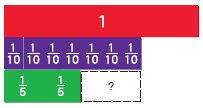
\(\frac{7}{10}-\frac{2}{5}=\)
\(\frac{□}{□}\)
Answer:
\(\frac{7}{10}\) – \(\frac{2}{5}\)
\(\frac{7}{10}\) – \(\frac{2}{5}\) • \(\frac{2}{2}\)
\(\frac{7}{10}\) – \(\frac{4}{10}\) = \(\frac{3}{10}\)
Question 2.
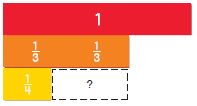
\(\frac{2}{3}-\frac{1}{4}=\)
\(\frac{□}{□}\)
Answer:
\(\frac{2}{3}\) – \(\frac{1}{4}\)
Now we have to make the fractions like denominators
\(\frac{2}{3}\) • \(\frac{4}{4}\) – \(\frac{1}{4}\) • \(\frac{3}{3}\)
\(\frac{8}{12}\) – \(\frac{3}{12}\) = \(\frac{5}{12}\)
Page No. 249
Use fraction strips to find the difference. Write your answer in simplest form.
Question 3.
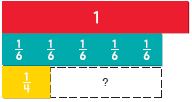
\(\frac{5}{6}-\frac{1}{4}=\)
\(\frac{□}{□}\)
Answer:
Step 1:
Find fraction strips, all with the same denominator, that fit exactly under the difference \(\frac{5}{6}-\frac{1}{4}\)
Step 2:
Find another set of fraction strips, all with the same the denominator, that fit exactly under the difference \(\frac{5}{6}-\frac{1}{4}\)
Step 3:
Find other fraction strips, all with the same denominator, that fit exactly under the difference \(\frac{5}{6}-\frac{1}{4}\)
\(\frac{5}{6}\) • \(\frac{4}{4}\) – \(\frac{1}{4}\) • \(\frac{6}{6}\)
\(\frac{20}{24}\) – \(\frac{6}{24}\) = \(\frac{14}{24}\) = \(\frac{7}{12}\)
Thus, \(\frac{5}{6}-\frac{1}{4}\) = \(\frac{7}{12}\)
Question 4.

\(\frac{1}{2}-\frac{3}{10}=\)
\(\frac{□}{□}\)
Answer:
\(\frac{1}{2}-\frac{3}{10}\)
\(\frac{1}{2}\) • \(\frac{5}{5}\) – \(\frac{3}{10}\)
\(\frac{5}{10}\) – \(\frac{3}{10}\) = \(\frac{2}{10}\)
Question 5.
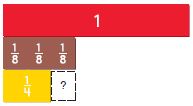
\(\frac{3}{8}-\frac{1}{4}=\)
\(\frac{□}{□}\)
Answer:
\(\frac{3}{8}-\frac{1}{4}\)
\(\frac{3}{8}\) – \(\frac{1}{4}\) • \(\frac{2}{2}\)
= \(\frac{3}{8}\) – \(\frac{2}{8}\) = \(\frac{1}{8}\)
Question 6.
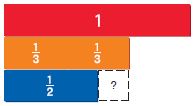
\(\frac{2}{3}-\frac{1}{2}=\)
\(\frac{□}{□}\)
Answer:
\(\frac{2}{3}-\frac{1}{2}\)
\(\frac{2}{3}\) • \(\frac{2}{2}\) – \(\frac{1}{2}\) • \(\frac{3}{3}\)
\(\frac{4}{6}-\frac{3}{6}\) = \(\frac{1}{6}\)
Use fraction strips to find the difference. Write your answer in simplest form.
Question 7.
\(\frac{3}{5}-\frac{3}{10}=\) \(\frac{□}{□}\)
Answer:
\(\frac{3}{5}-\frac{3}{10}\)
\(\frac{3}{5}\) • \(\frac{2}{2}\) – \(\frac{3}{10}\)
= \(\frac{6}{10}\) – \(\frac{3}{10}\) = \(\frac{3}{10}\)
Question 8.
\(\frac{5}{12}-\frac{1}{3}=\) \(\frac{□}{□}\)
Answer:
\(\frac{5}{12}-\frac{1}{3}\)
Make the denominators equal and then subtract the subtract the fraction with lide denominators.
\(\frac{5}{12}\) – \(\frac{1}{3}\) • \(\frac{4}{4}\)
\(\frac{5}{12}\) – \(\frac{4}{12}\) = \(\frac{1}{12}\)
Question 9.
\(\frac{1}{2}-\frac{1}{10}=\) \(\frac{□}{□}\)
Answer:
\(\frac{1}{2}-\frac{1}{10}\)
Make the denominators equal and then subtract the subtract the fraction with lide denominators.
\(\frac{1}{2}\) • \(\frac{5}{5}\) – \(\frac{1}{10}\)
\(\frac{5}{10}\) – \(\frac{1}{10}\) = \(\frac{4}{10}\)
Question 10.
\(\frac{3}{5}-\frac{1}{2}=\) \(\frac{□}{□}\)
Answer:
\(\frac{3}{5}-\frac{1}{2}\)
Make the denominators equal and then subtract the subtract the fraction with lide denominators.
\(\frac{3}{5}\) • \(\frac{2}{2}\) – \(\frac{1}{2}\) • \(\frac{5}{5}\)
\(\frac{6}{10}-\frac{5}{10}\) = \(\frac{1}{10}\)
Question 11.
\(\frac{7}{8}-\frac{1}{4}=\) \(\frac{□}{□}\)
Answer:
\(\frac{7}{8}-\frac{1}{4}\)
Make the denominators equal and then subtract the subtract the fraction with lide denominators.
\(\frac{7}{8}\) – \(\frac{1}{4}\) • \(\frac{2}{2}\)
\(\frac{7}{8}\) – \(\frac{2}{8}\) = \(\frac{5}{8}\)
Question 12.
\(\frac{5}{6}-\frac{2}{3}=\) \(\frac{□}{□}\)
Answer:
\(\frac{5}{6}-\frac{2}{3}\)
Make the denominators equal and then subtract the subtract the fraction with lide denominators.
\(\frac{5}{6}\) – \(\frac{2}{3}\) • \(\frac{2}{2}\)
\(\frac{5}{6}\) – \(\frac{4}{6}\)
\(\frac{1}{6}\)
Question 13.
\(\frac{3}{4}-\frac{1}{3}=\) \(\frac{□}{□}\)
Answer:
\(\frac{3}{4}-\frac{1}{3}\)
\(\frac{3}{4}\) • \(\frac{3}{3}\) – \(\frac{1}{3}\) • \(\frac{4}{4}\)
\(\frac{9}{12}\) – \(\frac{4}{12}\) = \(\frac{5}{12}\)
Question 14.
\(\frac{5}{6}-\frac{1}{2}=\) \(\frac{□}{□}\)
Answer:
\(\frac{5}{6}-\frac{1}{2}\)
\(\frac{5}{6}\) – \(\frac{1}{2}\) • \(\frac{3}{3}\)
\(\frac{5}{6}\) – \(\frac{3}{6}\) = \(\frac{2}{6}\)
\(\frac{5}{6}-\frac{1}{2}=\) \(\frac{2}{6}\)
Question 15.
\(\frac{3}{4}-\frac{7}{12}=\) \(\frac{□}{□}\)
Answer:
\(\frac{3}{4}-\frac{7}{12}\)
\(\frac{3}{4}\) • \(\frac{3}{3}\) – \(\frac{7}{12}\)
\(\frac{9}{12}\) – \(\frac{7}{12}\) = \(\frac{2}{12}\)
\(\frac{3}{4}-\frac{7}{12}=\) \(\frac{2}{12}\)
Question 16.
Explain how your model for \(\frac{3}{5}-\frac{1}{2}\) is different from your model for \(\frac{3}{5}-\frac{3}{10}\).
Type below:
_________
Answer:
\(\frac{3}{5}-\frac{3}{10}\)
\(\frac{3}{5}\) • \(\frac{2}{2}\) – \(\frac{3}{10}\)
\(\frac{6}{10}\) – \(\frac{3}{10}\) = \(\frac{3}{10}\)
UNLOCK the Problem – Page No. 250
Question 17.
The picture at the right shows how much pizza was left over from lunch. Jason eats \(\frac{1}{4}\) of the whole pizza for dinner. Which subtraction sentence represents the amount of pizza that is remaining after dinner?
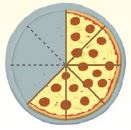
a. What problem are you being asked to solve?
Type below:
_________
Answer: I am asked to solve which subtraction sentence represents the amount of pizza that is remaining after dinner.
Question 17.
b. How will you use the diagram to solve the problem?
Type below:
_________
Answer: I will use number of slices left in the pizza to solve the problem.
Question 17.
c. Jason eats \(\frac{1}{4}\) of the whole pizza. How many slices does he eat?
______ slices
Answer: 2 slices
Explanation:
Given that, Jason eats \(\frac{1}{4}\) of the whole pizza.
The pizza is cut into 8 slices.
So, 8 × \(\frac{1}{4}\) = 2 slices.
Thus Jason ate 2 slices.
Question 17.
d. Redraw the diagram of the pizza. Shade the sections of pizza that are remaining after Jason eats his dinner.
Type below:
_________
Question 17.
e. Write a fraction to represent the amount of pizza that is remaining.
\(\frac{□}{□}\) of a pizza
Answer: \(\frac{3}{8}\) of a pizza
Explanation:
The fraction of pizzz Jason ate = \(\frac{1}{4}\)
Number of slices left = \(\frac{5}{8}\)
Now subtract \(\frac{5}{8}\) – \(\frac{1}{4}\)
= \(\frac{3}{8}\)
Thus the fraction to represent the amount of pizza that is remaining is \(\frac{3}{8}\)
Question 17.
f. Fill in the bubble for the correct answer choice above.
Options:
a. 1 – \(\frac{1}{4}\) = \(\frac{3}{4}\)
b. \(\frac{5}{8}\) – \(\frac{1}{4}\) = \(\frac{3}{8}\)
c. \(\frac{3}{8}\) – \(\frac{1}{4}\) = \(\frac{2}{8}\)
d. 1 – \(\frac{3}{8}\) = \(\frac{5}{8}\)
Answer: B
The fraction of pizzz Jason ate = \(\frac{1}{4}\)
Number of slices left = \(\frac{5}{8}\)
Now subtract \(\frac{5}{8}\) – \(\frac{1}{4}\) = \(\frac{3}{8}\)
Thus the correct answer is option B.
Question 18.
The diagram shows what Tina had left from a yard of fabric. She now uses \(\frac{2}{3}\) yard of fabric for a project. How much of the original yard of fabric does Tina have left after the project?
![]()
Options:
a. \(\frac{2}{3}\) yard
b. \(\frac{1}{2}\) yard
c. \(\frac{1}{3}\) yard
d. \(\frac{1}{6}\) yard
Answer: \(\frac{1}{3}\) yard
Explanation:
The original yard of fabric is 6
Tina uses \(\frac{2}{3}\) yard of fabric for a project.
\(\frac{1}{1}\) – \(\frac{2}{3}\)
\(\frac{3}{3}\) – \(\frac{2}{3}\) = \(\frac{1}{3}\) yard
Share and Show – Page No. 253
Estimate the sum or difference.
Question 1.
\(\frac{5}{6}+\frac{3}{8}\)
a. Round \(\frac{5}{6}\) to its closest benchmark. ____
b. Round \(\frac{3}{8}\) to its closest benchmark. ____
c. Add to find the estimate. ____ + ____ = ____
_____ \(\frac{□}{□}\)
Answer:
a. Round \(\frac{5}{6}\) to its closest benchmark. \(\frac{6}{6}\) or 1.
b. Round \(\frac{3}{8}\) to its closest benchmark. \(\frac{4}{8}\) or \(\frac{1}{2}\)
c. Add to find the estimate. ____ + ____ = ____
1 + \(\frac{1}{2}\) = \(\frac{3}{2}\) = 1 \(\frac{1}{2}\)
Question 2.
\(\frac{5}{9}-\frac{3}{8}\)
_____
Answer: 0
Explanation:
Step 1: Place a point at \(\frac{5}{9}\) on the number line.
The fraction is between 0 and \(\frac{1}{2}\).
The fraction rounded to \(\frac{5}{9}\) is \(\frac{1}{2}\)
Step 2: Place a point at \(\frac{3}{8}\) on the number line.
The fraction is between 0 and \(\frac{1}{2}\).
The fraction rounded to \(\frac{3}{8}\) is \(\frac{1}{2}\).
\(\frac{1}{2}\) – \(\frac{1}{2}\) = 0
Question 3.
\(\frac{6}{7}+2 \frac{4}{5}\)
_____
Answer: 4
Explanation:
Step 1: Place a point at \(\frac{6}{7}\) on the number line.
The fraction is between \(\frac{1}{2}\) and 1.
Step 2: Place a point at \(\frac{4}{5}\) on the number line.
The fraction is between \(\frac{1}{2}\) and 1.
1 + 3 = 4
Question 4.
\(\frac{5}{6}+\frac{2}{5}\)
_____ \(\frac{□}{□}\)
Answer: 1 \(\frac{1}{2}\)
Explanation:
Step 1: Place a point at \(\frac{5}{6}\) on the number line.
The fraction is between \(\frac{1}{2}\) and 1.
Step 2: Place a point at \(\frac{2}{5}\) on the number line.
The fraction is between 0 and \(\frac{1}{2}\).
1 + \(\frac{1}{2}\) = \(\frac{3}{2}\) = 1 \(\frac{1}{2}\)
Question 5.
\(3 \frac{9}{10}-1 \frac{2}{9}\)
_____
Answer: 3
Explanation:
Step 1: Place a point at \(\frac{9}{10}\) on the number line.
The fraction is between \(\frac{1}{2}\) and 1.
Step 2: Place a point at \(\frac{2}{9}\) on the number line.
The fraction is between 0 and \(\frac{1}{2}\).
3 × 1 – 1 × 0 = 3 – 0 = 3
\(3 \frac{9}{10}-1 \frac{2}{9}\) = 3
Question 6.
\(\frac{4}{6}+\frac{1}{9}\)
\(\frac{□}{□}\)
Answer: \(\frac{1}{2}\)
Explanation:
Step 1: Place a point at \(\frac{4}{6}\) on the number line.
The fraction is between \(\frac{1}{2}\) and 1.
Step 2: Place a point at \(\frac{1}{9}\) on the number line.
The fraction is between 0 and \(\frac{1}{2}\).
So, \(\frac{1}{2}\) + 0 = \(\frac{1}{2}\)
\(\frac{4}{6}+\frac{1}{9}\) = \(\frac{1}{2}\)
Question 7.
\(\frac{9}{10}-\frac{1}{9}\)
_____
Answer: 1
Explanation:
Step 1: Place a point at \(\frac{9}{10}\) on the number line.
The fraction is between \(\frac{1}{2}\) and 1.
Step 2: Place a point at \(\frac{1}{9}\) on the number line.
The fraction is between 0 and \(\frac{1}{2}\).
1 – 0 = 1
\(\frac{9}{10}-\frac{1}{9}\) = 1
On Your Own
Estimate the sum or difference.
Question 8.
\(\frac{5}{8}-\frac{1}{5}\)
\(\frac{□}{□}\)
Answer: \(\frac{1}{2}\)
Explanation:
Step 1: Place a point at \(\frac{5}{8}\) on the number line.
The fraction is between \(\frac{1}{2}\) and 1.
Step 2: Place a point at \(\frac{1}{5}\) on the number line.
The fraction is between 0 and \(\frac{1}{2}\).
1 – \(\frac{1}{2}\) = \(\frac{1}{2}\)
Question 9.
\(\frac{1}{6}+\frac{3}{8}\)
\(\frac{□}{□}\)
Answer: \(\frac{1}{2}\)
Explanation:
Step 1: Place a point at \(\frac{1}{6}\) on the number line.
The fraction is between 0 and \(\frac{1}{2}\)
Step 2: Place a point at \(\frac{3}{8}\) on the number line.
The fraction is between 0 and \(\frac{1}{2}\)
0 + \(\frac{1}{2}\) = \(\frac{1}{2}\)
Question 10.
\(\frac{6}{7}-\frac{1}{5}\)
_____
Answer: 1
Explanation:
Step 1: Place a point at \(\frac{6}{7}\) on the number line.
The fraction is between \(\frac{1}{2}\) and 1.
Step 2: Place a point at \(\frac{1}{5}\) on the number line.
The fraction is between 0 and \(\frac{1}{2}\)
1 – 0 = 1
\(\frac{6}{7}-\frac{1}{5}\) = 1
Question 11.
\(\frac{11}{12}+\frac{6}{10}\)
_____ \(\frac{□}{□}\)
Answer: 1 \(\frac{1}{2}\)
Explanation:
Step 1: Place a point at \(\frac{11}{12}\) on the number line.
The fraction is between \(\frac{1}{2}\) and 1
Step 2: Place a point at \(\frac{6}{10}\) on the number line.
The fraction is between \(\frac{1}{2}\) and 1
1 + \(\frac{1}{2}\) = \(\frac{3}{2}\) = 1 \(\frac{1}{2}\)
\(\frac{11}{12}+\frac{6}{10}\) = 1 \(\frac{1}{2}\)
Question 12.
\(\frac{9}{10}-\frac{1}{2}\)
\(\frac{□}{□}\)
Answer: \(\frac{1}{2}\)
Explanation:
Step 1: Place a point at \(\frac{9}{10}\) on the number line.
The fraction is between \(\frac{1}{2}\) and 1.
Step 2: Place a point at \(\frac{1}{2}\) on the number line.
The fraction is between 0 and \(\frac{1}{2}\)
1 – \(\frac{1}{2}\) = \(\frac{1}{2}\)
\(\frac{9}{10}-\frac{1}{2}\) = \(\frac{1}{2}\)
Question 13.
\(\frac{3}{6}+\frac{4}{5}\)
_____ \(\frac{□}{□}\)
Answer: 1 \(\frac{1}{2}\)
Explanation:
Step 1: Place a point at \(\frac{3}{6}\) on the number line.
The fraction is between 0 and \(\frac{1}{2}\)
Step 2: Place a point at \(\frac{4}{5}\) on the number line.
The fraction is between \(\frac{1}{2}\) and 1
\(\frac{1}{2}\) + 1 = \(\frac{3}{2}\) = 1 \(\frac{1}{2}\)
\(\frac{3}{6}+\frac{4}{5}\) = 1 \(\frac{1}{2}\)
Question 14.
\(\frac{5}{6}-\frac{3}{8}\)
\(\frac{□}{□}\)
Answer: \(\frac{1}{2}\)
Explanation:
Step 1: Place a point at \(\frac{5}{6}\) on the number line.
The fraction is between \(\frac{1}{2}\) and 1.
Step 2: Place a point at \(\frac{3}{8}\) on the number line.
The fraction is between 0 and \(\frac{1}{2}\)
1 – \(\frac{1}{2}\) = \(\frac{1}{2}\)
\(\frac{5}{6}-\frac{3}{8}\) = \(\frac{1}{2}\)
Question 15.
\(\frac{1}{7}+\frac{8}{9}\)
_____
Answer: 1
Explanation:
Step 1: Place a point at \(\frac{1}{7}\) on the number line.
The fraction is between 0 and \(\frac{1}{2}\)
Step 2: Place a point at \(\frac{8}{9}\) on the number line.
The fraction is between \(\frac{1}{2}\) and 1.
0 + 1 = 1
\(\frac{1}{7}+\frac{8}{9}\) = 1
Question 16.
\(3 \frac{5}{12}-3 \frac{1}{10}\)
\(\frac{□}{□}\)
Answer: \(\frac{1}{2}\)
Explanation:
Step 1: Place a point at \(\frac{5}{12}\) on the number line.
The fraction is between 0 and \(\frac{1}{2}\)
Step 2: Place a point at \(\frac{1}{10}\) on the number line.
The fraction is between 0 and \(\frac{1}{2}\)
\(\frac{1}{2}\) – 0 = \(\frac{1}{2}\)
\(3 \frac{5}{12}-3 \frac{1}{10}\) = \(\frac{1}{2}\)
Problem Solving – Page No. 254
Question 17.
Lisa and Valerie are picnicking in Trough Creek State Park in Pennsylvania. Lisa has brought a salad that she made with \(\frac{3}{4}\) cup of strawberries, \(\frac{7}{8}\) cup of peaches, and \(\frac{1}{6}\) cup of blueberries. About how many total cups of fruit are in the salad?
_____ cups
Answer: 2 cups
Explanation:
Lisa and Valerie are picnicking in Trough Creek State Park in Pennsylvania.
Lisa has brought a salad that she made with \(\frac{3}{4}\) cup of strawberries, \(\frac{7}{8}\) cup of peaches, and \(\frac{1}{6}\) cup of blueberries.
Step 1: Place \(\frac{3}{4}\) on the number line.
The fraction is between \(\frac{1}{2}\) and 1.
Step 2: Place \(\frac{7}{8}\) on the number line.
The fraction is between \(\frac{1}{2}\) and 1.
Step 3: Place \(\frac{1}{6}\) on the number line.
The fraction is between 0 and \(\frac{1}{2}\).
1 + 1 + 0 = 2
Thus 2 cups of fruit are in the salad.
Question 18.
At Trace State Park in Mississippi, there is a 25-mile mountain bike trail. If Tommy rode \(\frac{1}{2}\) of the trail on Saturday and \(\frac{1}{5}\) of the trail on Sunday, about what fraction of the trail did he ride?
\(\frac{□}{□}\)
Answer: \(\frac{1}{2}\)
Explanation:
At Trace State Park in Mississippi, there is a 25-mile mountain bike trail.
If Tommy rode \(\frac{1}{2}\) of the trail on Saturday and \(\frac{1}{5}\) of the trail on Sunday
Step 1: Place \(\frac{1}{2}\) on the number line.
\(\frac{1}{2}\) lies between 0 and \(\frac{1}{2}\)
Step 2: Place \(\frac{1}{5}\) on the number line.
\(\frac{1}{5}\) 0 and \(\frac{1}{2}\)
The number closer to \(\frac{1}{5}\) is 0
\(\frac{1}{2}\) – 0 = \(\frac{1}{2}\)
The estimated fraction of the trail he ride is \(\frac{1}{2}\)
Question 19.
Explain how you know that \(\frac{5}{8}+\frac{6}{10}\) is greater than 1.
Type below:
__________
Answer:
Step 1: Place \(\frac{5}{8}\) on the number line.
\(\frac{5}{8}\) is closer to \(\frac{1}{2}\)
Step 2: Place \(\frac{6}{10}\) on the number line.
\(\frac{6}{10}\) lies between \(\frac{1}{2}\) and 1.
\(\frac{6}{10}\) is closer to \(\frac{1}{2}\)
\(\frac{1}{2}\) + \(\frac{1}{2}\) = 1
Question 20.
Nick estimated that \(\frac{5}{8}+\frac{4}{7}\) is about 2.
Explain how you know his estimate is not reasonable.
Type below:
__________
Answer:
Step 1: Place \(\frac{5}{8}\) on the number line.
\(\frac{5}{8}\) is closer to \(\frac{1}{2}\)
Step 2: Place \(\frac{4}{7}\) on the number line.
\(\frac{4}{7}\) lies between \(\frac{1}{2}\) and 1.
\(\frac{1}{2}\) + \(\frac{1}{2}\) = 1
By this, we can say that Nick’s estimation was wrong.
Question 21.
Test Prep Jake added \(\frac{1}{8}\) cup of sunflower seeds and \(\frac{4}{5}\) cup of banana chips to his sundae. Which is the best estimate of the total amount of toppings Jake added to his sundae?
Options:
a. about \(\frac{1}{2}\) cup
b. about 1 cup
c. about 1 \(\frac{1}{2}\) cups
d. about 2 cups
Answer: about 1 cup
Explanation:
Given, Test Prep Jake added \(\frac{1}{8}\) cup of sunflower seeds and \(\frac{4}{5}\) cup of banana chips to his sundae
Step 1: Place \(\frac{1}{8}\) on the number line.
\(\frac{1}{8}\) lies between 0 and \(\frac{1}{2}\)
Step 2: Place \(\frac{4}{5}\) on the number line.
\(\frac{4}{5}\) lies between \(\frac{1}{2}\) and 1.
0 + 1 = 1
The best estimate of the total amount of toppings Jake added to his sundae is about 1 cup.
Share and Show – Page No. 256
Question 1.
Find a common denominator of \(\frac{1}{6}\) and \(\frac{1}{9}\) . Rewrite the pair of fractions using the common denominator.
• Multiply the denominators.
A common denominator of \(\frac{1}{6}\) and \(\frac{1}{9}\) is ____.
• Rewrite the pair of fractions using the common denominator.
Type below:
_________
Answer:
Common denominator is 18.
\(\frac{1}{6}\) × \(\frac{3}{3}\) = \(\frac{3}{18}\)
\(\frac{1}{9}\) × \(\frac{2}{2}\) = \(\frac{2}{18}\)
The pair of fractions using the common denominator is \(\frac{3}{18}\), \(\frac{2}{18}\)
Use a common denominator to write an equivalent fraction for each fraction.
Question 2.
\(\frac{1}{3}, \frac{1}{5}\)
common denominator: _________
Type below:
_________
Answer: 15
Explanation:
Multiply the denominators of the fraction.
\(\frac{1}{3}\) × \(\frac{1}{5}\) = \(\frac{1}{15}\)
Thus the common denominator is 15.
Question 3.
\(\frac{2}{3}, \frac{5}{9}\)
common denominator: _________
Type below:
_________
Answer: 27
Explanation:
Multiply the denominators
\(\frac{2}{3}\) × \(\frac{5}{9}\)
= 3 × 9 = 27
Thus the common denominator of \(\frac{2}{3}, \frac{5}{9}\) is 27.
Question 4.
\(\frac{2}{9}, \frac{1}{15}\)
common denominator: _________
Type below:
_________
Answer: 45
Explanation:
Multiply the denominators
\(\frac{2}{9}\) × \(\frac{1}{15}\)
The least common denominator of 15 and 9 is 45.
So, the common denominator of \(\frac{2}{9}, \frac{1}{15}\) is 45.
Page No. 257
Use the least common denominator to write an equivalent fraction for each fraction.
Question 5.
\(\frac{1}{4}, \frac{3}{8}\)
least common denominator: ______
Type below:
_________
Answer: 8
Explanation:
First multiply the denominators of the fractions \(\frac{1}{4}, \frac{3}{8}\)
4 × 8 = 32
The least common denominator is 8
The equivalent fractions with LCD
\(\frac{1}{4}\) = \(\frac{2}{8}\)
\(\frac{3}{8}\) = \(\frac{3}{8}\)
Question 6.
\(\frac{11}{12}, \frac{5}{8}\)
least common denominator: ______
Type below:
_________
Answer: 24
Explanation:
First, multiply the denominators of the fractions.
12 × 8 = 96
The least common denominator of 12 and 8 is 24.
The equivalent fractions with LCD
\(\frac{11}{12}\) × \(\frac{2}{2}\)= \(\frac{22}{24}\)
\(\frac{5}{8}\) × \(\frac{3}{3}\) = \(\frac{15}{24}\)
Question 7.
\(\frac{4}{5}, \frac{1}{6}\)
least common denominator: ______
Type below:
_________
Answer: 30
Explanation:
First, multiply the denominators of the fractions.
5 × 6 = 30
The least common denominator (LCD) = 30
\(\frac{4}{5}\) × \(\frac{6}{6}\)= \(\frac{24}{30}\)
\(\frac{1}{6}\) × \(\frac{5}{5}\) = \(\frac{5}{30}\)
On Your Own
Use a common denominator to write an equivalent fraction for each fraction.
Question 8.
\(\frac{3}{5}, \frac{1}{4}\)
common denominator: ______
Type below:
_________
Answer: 20
Explanation:
Multiply the denominators of the fractions to find the common denominator.
5 × 4 = 20
So, the common denominator of \(\frac{3}{5}, \frac{1}{4}\) is 20.
Question 9.
\(\frac{5}{8}, \frac{1}{5}\)
common denominator: ______
Type below:
_________
Answer: 40
Explanation:
Multiply the denominators of the fractions to find the common denominator.
8 × 5 = 40
So, the common denominator of \(\frac{5}{8}, \frac{1}{5}\) is 40.
Question 10.
\(\frac{1}{12}, \frac{1}{2}\)
common denominator: ______
Type below:
_________
Answer: 24
Explanation:
Multiply the denominators of the fractions to find the common denominator.
12 × 2 = 24
The common denominator of \(\frac{1}{12}, \frac{1}{2}\) is 24.
Practice: Copy and Solve Use the least common denominator to write an equivalent fraction for each fraction.
Question 11.
\(\frac{1}{6}, \frac{4}{9}\)
Type below:
_________
Answer: \(\frac{3}{18}, \frac{8}{18}\)
Explanation:
Multiply the denominators of the fractions.
The Least Common Denominator = 18
Now rewrite the fractions
\(\frac{1}{6}\) × \(\frac{3}{3}\) = \(\frac{3}{18}\)
\(\frac{4}{9}\) × \(\frac{2}{2}\) = \(\frac{8}{18}\)
Question 12.
\(\frac{7}{9}, \frac{8}{27}\)
Type below:
_________
Answer: \(\frac{21}{27}, \frac{8}{27}\)
Explanation:
Multiply the denominators of the fractions.
The Least Common Denominator = 27
Now rewrite the fractions
\(\frac{7}{9}\) × \(\frac{3}{3}\) = \(\frac{21}{27}\)
\(\frac{8}{27}\) × \(\frac{1}{1}\) = \(\frac{8}{27}\)
Question 13.
\(\frac{7}{10}, \frac{3}{8}\)
Type below:
_________
Answer: \(\frac{28}{40}, \frac{15}{40}\)
Explanation:
Multiply the denominators of the fractions.
The Least Common Denominator = 40
Now rewrite the fractions
\(\frac{7}{10}\) × \(\frac{4}{4}\) = \(\frac{28}{40}\)
\(\frac{3}{8}\) × \(\frac{5}{5}\) = \(\frac{15}{40}\)
Question 14.
\(\frac{1}{3}, \frac{5}{11}\)
Type below:
_________
Answer: \(\frac{11}{33}, \frac{15}{33}\)
Explanation:
Multiply the denominators of the fractions.
The Least Common Denominator = 33
Now rewrite the fractions
\(\frac{1}{3}\) × \(\frac{11}{11}\) = \(\frac{11}{33}\)
\(\frac{5}{11}\) × \(\frac{3}{3}\) = \(\frac{15}{33}\)
Question 15.
\(\frac{5}{9}, \frac{4}{15}\)
Type below:
_________
Answer: \(\frac{25}{45}, \frac{12}{45}\)
Explanation:
Multiply the denominators of the fractions.
The Least Common Denominator of \(\frac{5}{9}, \frac{4}{15}\)= 45
Now rewrite the input fractions
\(\frac{5}{9}\) × \(\frac{5}{5}\) = \(\frac{25}{45}\)
\(\frac{4}{15}\) × \(\frac{3}{3}\) = \(\frac{12}{45}\)
Question 16.
\(\frac{1}{6}, \frac{4}{21}\)
Type below:
_________
Answer: \(\frac{7}{42}, \frac{8}{42}\)
Explanation:
Multiply the denominators of the fractions.
The Least Common Denominator = 42
Now rewrite the fractions
\(\frac{1}{6}\) × \(\frac{7}{7}\) = \(\frac{7}{42}\)
\(\frac{4}{21}\) × \(\frac{2}{2}\) = \(\frac{8}{42}\)
Question 17.
\(\frac{5}{14}, \frac{8}{42}\)
Type below:
_________
Answer: \(\frac{15}{42}, \frac{8}{42}\)
Explanation:
Multiply the denominators of the fractions.
The Least Common Denominator = 42
Now rewrite the fractions
\(\frac{5}{14}\) × \(\frac{3}{3}\) = \(\frac{15}{42}\)
\(\frac{8}{42}\) × \(\frac{1}{1}\) = \(\frac{8}{42}\)
Question 18.
\(\frac{7}{12}, \frac{5}{18}\)
Type below:
_________
Answer: \(\frac{21}{36}, \frac{10}{36}\)
Explanation:
Multiply the denominators of the fractions.
The Least Common Denominator = 36
Now rewrite the fractions
\(\frac{7}{12}\) × \(\frac{3}{3}\) = \(\frac{21}{36}\)
\(\frac{5}{18}\) × \(\frac{2}{2}\) = \(\frac{10}{36}\)
Algebra Write the unknown number for each ■.
Question 19.
\(\frac{1}{5}, \frac{1}{8}\)
least common denominator: ■
■ = ______
Answer: 40
Explanation:
Multiply the denominators of the fractions.
5 × 8 = 40
Therefore, ■ = 40
Question 20.
\(\frac{2}{5}, \frac{1}{■}\)
least common denominator: 15
■ = ______
Answer: 3
Explanation:
Multiply the denominators of the fractions.
5 × ■ = 15
■ = 15/5 = 3
Thus ■ = 3
Question 21.
\(\frac{3}{■}, \frac{5}{6}\)
least common denominator: 42
■ = ______
Answer: 7
Explanation:
\(\frac{3}{■}, \frac{5}{6}\)
■ × 6 = 42
■ = 42/6
■ = 7
UNLOCK the Problem – Page No. 258

Question 22.
Katie made two pies for the bake sale. One was cut into three equal slices and the other into 5 equal slices. She will continue to cut the pies so each one has the same number of equal-sized slices. What is the least number of equal-sized slices each pie could have?
a. What information are you given?
Type below:
_________
Answer: I have the information about the two pies for the bake sale. One was cut into three equal slices and the other into 5 equal slices. She will continue to cut the pies so each one has the same number of equal-sized slices.
Question 22.
b. What problem are you being asked to solve?
Type below:
_________
Answer: I am asked to solve the least number of equal-sized slices each pie could have.
Question 22.
c. When Katie cuts the pies more, can she cut each pie the same number of times and have all the slices the same size? Explain.
Type below:
_________
Answer: Yes she can cut into more equal pieces. Katie can cut the pie into 6 equal pieces and 10 equal pieces. But the least number of equal-sized slices each pie could have is 3 and 5.
Question 22.
d. Use the diagram to show the steps you use to solve the problem.
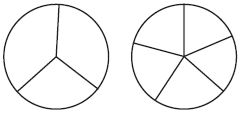
Type below:
_________
Answer:
There are 2 pies. One pie is cut into 3 equal pieces and the second pie is cut into 5 equal pieces.
So, there are 15 pieces of pies.
Question 22.
e. Complete the sentences.
The least common denominator of \(\frac{1}{3}\) and \(\frac{1}{5}\) is ____.
Katie can cut each piece of the first pie into ____ and each piece of the second pie into ____ .
That means that Katie can cut each pie into pieces that are ____ of the whole pie.
Type below:
_________
Answer:
The least common denominator of \(\frac{1}{3}\) and \(\frac{1}{5}\) is 15
5 × 3 = 15
Katie can cut each piece of the first pie into three and each piece of the second pie into five.
That means that Katie can cut each pie into pieces that are 15 of the whole pie.
Question 23.
A cookie recipe calls for \(\frac{1}{3}\) cup of brown sugar and \(\frac{1}{8}\) cup of walnuts. Find the least common denominator of the fractions used in the recipe.
____
Answer: 24
Explanation:
A cookie recipe calls for \(\frac{1}{3}\) cup of brown sugar and \(\frac{1}{8}\) cup of walnuts.
We can calculate the LCD by multiplying the denominators of the fraction.
3 × 8 = 24.
Question 24.
Test Prep Which fractions use the least common denominator and are equivalent to \(\frac{5}{8}\) and \(\frac{7}{10}\) ?
Options:
a. \(\frac{10}{40} \text { and } \frac{14}{40}\)
b. \(\frac{25}{40} \text { and } \frac{28}{40}\)
c. \(\frac{25}{80} \text { and } \frac{21}{80}\)
d. \(\frac{50}{80} \text { and } \frac{56}{80}\)
Answer: \(\frac{50}{80} \text { and } \frac{56}{80}\)
Explanation:
The least common denominator of \(\frac{5}{8}\) and \(\frac{7}{10}\) is 80.
\(\frac{5}{8}\) × \(\frac{10}{10}\) and \(\frac{7}{10}\) × \(\frac{8}{8}\)
= \(\frac{50}{80} \text { and } \frac{56}{80}\)
Thus the correct answer is option D.
Share and Show – Page No. 260
Find the sum or difference. Write your answer in simplest form.
Question 1.
\(\frac{5}{12}+\frac{1}{3}\)
\(\frac{□}{□}\)
Answer:
Find a common denominator by multiplying the denominators.
\(\frac{5}{12}+\frac{1}{3}\)
\(\frac{5}{12}\) + \(\frac{1}{3}\) × \(\frac{4}{4}\)
\(\frac{5}{12}\) + \(\frac{4}{12}\)
\(\frac{9}{12}\)
Question 2.
\(\frac{2}{5}+\frac{3}{7}\)
\(\frac{□}{□}\)
Answer:
Find a common denominator by multiplying the denominators.
Use the common denominator to write equivalent fractions with like denominators. Then add, and write your answer in simplest form.
\(\frac{2}{5}+\frac{3}{7}\)
\(\frac{2}{5}\) × \(\frac{7}{7}\) + \(\frac{3}{7}\) × \(\frac{5}{5}\)
\(\frac{14}{35}+\frac{15}{35}\)
= \(\frac{29}{35}\)
\(\frac{2}{5}+\frac{3}{7}\) = \(\frac{29}{35}\)
Question 3.
\(\frac{1}{6}+\frac{3}{4}\)
\(\frac{□}{□}\)
Answer:
Find a common denominator by multiplying the denominators.
Use the common denominator to write equivalent fractions with like denominators. Then add, and write your answer in simplest form.
\(\frac{1}{6}\) × \(\frac{2}{2}\) + \(\frac{3}{4}\) × \(\frac{3}{3}\)
\(\frac{2}{12}+\frac{9}{12}\) = \(\frac{11}{12}\)
So, \(\frac{1}{6}+\frac{3}{4}\) = \(\frac{11}{12}\)
Question 4.
\(\frac{3}{4}-\frac{1}{8}\)
\(\frac{□}{□}\)
Answer:
First, find a common denominator by multiplying the denominators.
Use the common denominator to write equivalent fractions with like denominators. Then add, and write your answer in simplest form.
\(\frac{3}{4}-\frac{1}{8}\)
\(\frac{3}{4}\) × \(\frac{2}{2}\) – \(\frac{1}{8}\)
\(\frac{6}{8}\) – \(\frac{1}{8}\) = \(\frac{5}{8}\)
Thus \(\frac{3}{4}-\frac{1}{8}\) = \(\frac{5}{8}\)
Question 5.
\(\frac{1}{4}-\frac{1}{7}\)
\(\frac{□}{□}\)
Answer:
First, find a common denominator by multiplying the denominators.
Use the common denominator to write equivalent fractions with like denominators. Then add, and write your answer in simplest form.
\(\frac{1}{4}-\frac{1}{7}\)
\(\frac{1}{4}\) × \(\frac{7}{7}\) – \(\frac{1}{7}\) × \(\frac{4}{4}\)
\(\frac{7}{28}\) – \(\frac{4}{28}\) = \(\frac{3}{28}\)
\(\frac{1}{4}-\frac{1}{7}\) = \(\frac{3}{28}\)
Question 6.
\(\frac{9}{10}-\frac{1}{4}\)
\(\frac{□}{□}\)
Answer:
First, find a common denominator by multiplying the denominators.
Use the common denominator to write equivalent fractions with like denominators. Then add, and write your answer in simplest form.
\(\frac{9}{10}-\frac{1}{4}\)
\(\frac{9}{10}\) × \(\frac{4}{4}\) – \(\frac{1}{4}\) × \(\frac{10}{10}\)
\(\frac{36}{40}\) – \(\frac{10}{40}\) = \(\frac{26}{40}\)
\(\frac{9}{10}-\frac{1}{4}\) = \(\frac{26}{40}\)
On Your Own – Page No. 261
Find the sum or difference. Write your answer in simplest form.
Question 7.
\(\frac{3}{8}+\frac{1}{4}\)
\(\frac{□}{□}\)
Answer: \(\frac{5}{8}\)
Explanation:
\(\frac{3}{8}+\frac{1}{4}\) = \(\frac{3}{8}\) + \(\frac{1}{4}\)
LCD = 8
\(\frac{3}{8}\) + \(\frac{1}{4}\) × \(\frac{2}{2}\)
\(\frac{3}{8}\) + \(\frac{2}{8}\) = \(\frac{5}{8}\)
Thus \(\frac{3}{8}+\frac{1}{4}\) = \(\frac{5}{8}\)
Question 8.
\(\frac{7}{8}+\frac{1}{10}\)
\(\frac{□}{□}\)
Answer:
\(\frac{7}{8}+\frac{1}{10}\)
First, find the Least Common Denominator and rewrite the fractions with the common denominator.
LCD = 40
\(\frac{7}{8}\) × \(\frac{5}{5}\) + \(\frac{1}{10}\) × \(\frac{4}{4}\)
\(\frac{35}{40}\) + \(\frac{4}{40}\) = \(\frac{39}{40}\)
\(\frac{7}{8}+\frac{1}{10}\) = \(\frac{39}{40}\)
Question 9.
\(\frac{2}{7}+\frac{3}{10}\)
\(\frac{□}{□}\)
Answer:
\(\frac{2}{7}+\frac{3}{10}\)
First, find the Least Common Denominator and rewrite the fractions with the common denominator.
LCD = 70
\(\frac{2}{7}\) × \(\frac{10}{10}\) + \(\frac{3}{10}\) × \(\frac{7}{7}\)
\(\frac{20}{70}\) + \(\frac{21}{70}\) = \(\frac{41}{70}\)
\(\frac{2}{7}+\frac{3}{10}\) = \(\frac{41}{70}\)
Question 10.
\(\frac{5}{6}+\frac{1}{8}\)
\(\frac{□}{□}\)
Answer:
\(\frac{5}{6}+\frac{1}{8}\)
First, find the Least Common Denominator and rewrite the fractions with the common denominator.
\(\frac{5}{6}\) + \(\frac{1}{8}\)
LCD = 24
\(\frac{5}{6}\) × \(\frac{4}{4}\) + \(\frac{1}{8}\) × \(\frac{3}{3}\)
\(\frac{20}{24}\) + \(\frac{3}{24}\) = \(\frac{23}{24}\)
\(\frac{5}{6}+\frac{1}{8}\) = \(\frac{23}{24}\)
Question 11.
\(\frac{5}{12}+\frac{5}{18}\)
\(\frac{□}{□}\)
Answer:
\(\frac{5}{12}+\frac{5}{18}\) = \(\frac{5}{12}\) + \(\frac{5}{18}\)
First, find the Least Common Denominator and rewrite the fractions with the common denominator.
LCD = 36
\(\frac{5}{12}\) × \(\frac{3}{3}\) + \(\frac{5}{18}\) × \(\frac{2}{2}\)
\(\frac{15}{36}\) + \(\frac{10}{36}\) = \(\frac{25}{36}\)
\(\frac{5}{12}+\frac{5}{18}\) = \(\frac{25}{36}\)
Question 12.
\(\frac{7}{16}+\frac{1}{4}\)
\(\frac{□}{□}\)
Answer:
\(\frac{7}{16}+\frac{1}{4}\)
First, find the Least Common Denominator and rewrite the fractions with the common denominator.
LCD = 16
\(\frac{7}{16}\) + \(\frac{1}{4}\) = \(\frac{7}{16}\) + \(\frac{1}{4}\) × \(\frac{4}{4}\)
\(\frac{7}{16}\) + \(\frac{4}{16}\) = \(\frac{11}{16}\)
Question 13.
\(\frac{5}{6}+\frac{3}{8}\)
\(\frac{□}{□}\)
Answer:
\(\frac{5}{6}+\frac{3}{8}\)
First, find the Least Common Denominator and rewrite the fractions with the common denominator.
\(\frac{5}{6}\) + \(\frac{3}{8}\)
LCD = 24
\(\frac{5}{6}\) × \(\frac{4}{4}\) + \(\frac{3}{8}\) × \(\frac{3}{3}\)
= \(\frac{20}{24}\) + \(\frac{9}{24}\) = \(\frac{29}{24}\)
\(\frac{5}{6}+\frac{3}{8}\) = \(\frac{29}{24}\)
Question 14.
\(\frac{3}{4}+\frac{1}{2}\)
\(\frac{□}{□}\)
Answer:
\(\frac{3}{4}+\frac{1}{2}\)
First, find the Least Common Denominator and rewrite the fractions with the common denominator.
\(\frac{3}{4}\) + \(\frac{1}{2}\)
LCD = 4
\(\frac{3}{4}\) + \(\frac{1}{2}\) × \(\frac{2}{2}\)
= \(\frac{3}{4}\) + \(\frac{2}{4}\) = \(\frac{5}{4}\)
The miced fractiion of \(\frac{5}{4}\) is 1 \(\frac{1}{4}\)
Question 15.
\(\frac{5}{12}+\frac{1}{4}\)
\(\frac{□}{□}\)
Answer:
\(\frac{5}{12}+\frac{1}{4}\)
First, find the Least Common Denominator and rewrite the fractions with the common denominator.
\(\frac{5}{12}\) + \(\frac{1}{4}\)
LCD = 12
\(\frac{5}{12}\) + \(\frac{1}{4}\) × \(\frac{3}{3}\)
\(\frac{5}{12}\) + \(\frac{3}{12}\) = \(\frac{8}{12}\) = \(\frac{2}{3}\)
Practice: Copy and Solve Find the sum or difference. Write your answer in simplest form.
Question 16.
\(\frac{1}{3}+\frac{4}{18}\)
\(\frac{□}{□}\)
Answer:
\(\frac{1}{3}+\frac{4}{18}\)
First, find the Least Common Denominator and rewrite the fractions with the common denominator.
LCD = 18
\(\frac{1}{3}\) + \(\frac{4}{18}\)
\(\frac{1}{3}\) × \(\frac{6}{6}\) + \(\frac{4}{18}\)
\(\frac{6}{18}\) + \(\frac{4}{18}\) = \(\frac{10}{18}\) = \(\frac{5}{9}\)
\(\frac{1}{3}+\frac{4}{18}\) = \(\frac{5}{9}\)
Question 17.
\(\frac{3}{5}+\frac{1}{3}\)
\(\frac{□}{□}\)
Answer:
\(\frac{3}{5}+\frac{1}{3}\)
First, find the Least Common Denominator and rewrite the fractions with the common denominator.
LCD = 15
\(\frac{3}{5}\) + \(\frac{1}{3}\)
\(\frac{3}{5}\) × \(\frac{3}{3}\) + \(\frac{1}{3}\) × \(\frac{5}{5}\)
\(\frac{9}{15}\) + \(\frac{5}{15}\) = \(\frac{14}{15}\)
\(\frac{3}{5}+\frac{1}{3}\) = \(\frac{14}{15}\)
Question 18.
\(\frac{3}{10}+\frac{1}{6}\)
\(\frac{□}{□}\)
Answer:
\(\frac{3}{10}+\frac{1}{6}\)
First, find the Least Common Denominator and rewrite the fractions with the common denominator.
LCD = 30
\(\frac{3}{10}\) + \(\frac{1}{6}\)
\(\frac{3}{10}\) × \(\frac{3}{3}\) + \(\frac{1}{6}\) × \(\frac{5}{5}\)
\(\frac{9}{30}\) + \(\frac{5}{30}\) = \(\frac{14}{30}\)
\(\frac{3}{10}+\frac{1}{6}\) = \(\frac{14}{30}\)
Question 19.
\(\frac{1}{2}+\frac{4}{9}\)
\(\frac{□}{□}\)
Answer:
\(\frac{1}{2}+\frac{4}{9}\)
First, find the Least Common Denominator and rewrite the fractions with the common denominator.
LCD = 18
\(\frac{1}{2}\) + \(\frac{4}{9}\)
\(\frac{1}{2}\) × \(\frac{9}{9}\) + \(\frac{4}{9}\) × \(\frac{2}{2}\)
= \(\frac{9}{18}\) + \(\frac{8}{18}\) = \(\frac{17}{18}\)
\(\frac{1}{2}+\frac{4}{9}\) = \(\frac{17}{18}\)
Question 20.
\(\frac{1}{2}-\frac{3}{8}\)
\(\frac{□}{□}\)
Answer:
\(\frac{1}{2}-\frac{3}{8}\)
First, find the Least Common Denominator and rewrite the fractions with the common denominator.
LCD = 8
\(\frac{1}{2}\) – \(\frac{3}{8}\)
\(\frac{1}{2}\) × \(\frac{4}{4}\) – \(\frac{3}{8}\)
\(\frac{4}{8}\) – \(\frac{3}{8}\) = \(\frac{1}{8}\)
\(\frac{1}{2}-\frac{3}{8}\) = \(\frac{1}{8}\)
Question 21.
\(\frac{5}{7}-\frac{2}{3}\)
\(\frac{□}{□}\)
Answer:
\(\frac{5}{7}-\frac{2}{3}\)
First, find the Least Common Denominator and rewrite the fractions with the common denominator.
LCD = 21
\(\frac{5}{7}\) – \(\frac{2}{3}\)
\(\frac{5}{7}\) × \(\frac{3}{3}\) – \(\frac{2}{3}\) × \(\frac{7}{7}\)
\(\frac{15}{21}\) – \(\frac{14}{21}\) = \(\frac{1}{21}\)
\(\frac{5}{7}-\frac{2}{3}\) = \(\frac{1}{21}\)
Question 22.
\(\frac{4}{9}-\frac{1}{6}\)
\(\frac{□}{□}\)
Answer:
\(\frac{4}{9}-\frac{1}{6}\)
First, find the Least Common Denominator and rewrite the fractions with the common denominator.
LCD = 18
\(\frac{4}{9}\) – \(\frac{1}{6}\)
\(\frac{4}{9}\) × \(\frac{2}{2}\) – \(\frac{1}{6}\) × \(\frac{3}{3}\)
\(\frac{8}{18}\) – \(\frac{3}{18}\) = \(\frac{5}{18}\)
\(\frac{4}{9}-\frac{1}{6}\) = \(\frac{5}{18}\)
Question 23.
\(\frac{11}{12}-\frac{7}{15}\)
\(\frac{□}{□}\)
Answer:
\(\frac{11}{12}-\frac{7}{15}\)
First, find the Least Common Denominator and rewrite the fractions with the common denominator.
LCD = 60
\(\frac{11}{12}\) – \(\frac{7}{15}\)
\(\frac{11}{12}\) × \(\frac{5}{5}\) – \(\frac{7}{15}\) × \(\frac{4}{4}\)
\(\frac{55}{60}\) – \(\frac{28}{60}\) = \(\frac{27}{60}\)
\(\frac{11}{12}-\frac{7}{15}\) = \(\frac{27}{60}\) = \(\frac{9}{20}\)
Algebra Find the unknown number.
Question 24.
\(\frac{9}{10}\) − ■ = \(\frac{1}{5}\)
■ = \(\frac{□}{□}\)
Answer:
\(\frac{9}{10}\) – \(\frac{1}{5}\) = ■
■ = \(\frac{9}{10}\) – \(\frac{1}{5}\)
■ = \(\frac{9}{10}\) – \(\frac{2}{10}\) = \(\frac{7}{10}\)
■ = \(\frac{7}{10}\)
Question 25.
\(\frac{5}{12}\) + ■ = \(\frac{1}{2}\)
■ = \(\frac{□}{□}\)
Answer:
\(\frac{5}{12}\) + ■ = \(\frac{1}{2}\)
\(\frac{5}{12}\) − \(\frac{1}{2}\) = – ■
– ■ = \(\frac{5}{12}\) − \(\frac{1}{2}\)
– ■ = \(\frac{5}{12}\) − \(\frac{1}{2}\) × \(\frac{6}{6}\)
– ■ = \(\frac{5}{12}\) − \(\frac{6}{12}\) = – \(\frac{1}{12}\)
■ = \(\frac{1}{12}\)
Problem Solving – Page No. 262
Use the picture for 26–27.
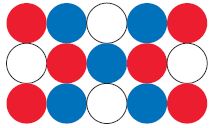
Question 26.
Sara is making a key chain using the bead design shown. What fraction of the beads in her design are either blue or red?
\(\frac{□}{□}\)
Answer: \(\frac{11}{15}\)
Explanation:
Total number of red beads = 6
Total number of blue beads = 5
Total number of beads = 6 + 5 = 11
The fraction of beads = \(\frac{11}{15}\)
Question 27.
In making the key chain, Sara uses the pattern of beads 3 times. After the key chain is complete, what fraction of the beads in the key chain are either white or blue?
______ \(\frac{□}{□}\)
Answer: 1 \(\frac{4}{5}\)
Explanation:
In making the key chain, Sara uses the pattern of beads 3 times.
Given that Sara uses the pattern of beads 3 times.
Total number of blue beads = 5
5 × 3 = 15
Number of white beads = 4
4 × 3 = 12
15 + 12 = 27
Actual number of beads = 15
So, the fraction is \(\frac{27}{15}\) = \(\frac{9}{5}\)
The mixed fraction of \(\frac{9}{5}\) is 1 \(\frac{4}{5}\)
Question 28.
Jamie had \(\frac{4}{5}\) of a spool of twine. He then used \(\frac{1}{2}\) of a spool of twine to make friendship knots. He claims to have \(\frac{3}{10}\) of the original spool of twine left over. Explain how you know whether Jamie’s claim is reasonable.
Type below:
_________
Answer: Jamie’s claim is reasonable
Explanation:
Jamie had \(\frac{4}{5}\) of a spool of twine. He then used \(\frac{1}{2}\) of a spool of twine to make friendship knots. He claims to have \(\frac{3}{10}\) of the original spool of twine left over.
To know whether his estimation is reasonable or not we have to subtract the total spool of twine from used spool of twine.
\(\frac{4}{5}\) – \(\frac{1}{2}\)
LCD = 10
\(\frac{4}{5}\) × \(\frac{2}{2}\) – \(\frac{1}{2}\) × \(\frac{5}{5}\)
\(\frac{8}{10}\) – \(\frac{5}{10}\) = \(\frac{3}{10}\)
By this is can that Jamie’s claim is reasonable.
Question 29.
Test Prep Which equation represents the fraction of beads that are green or yellow?
![]()
Options:
a. \(\frac{1}{4}+\frac{1}{8}=\frac{3}{8}\)
b. [atex]\frac{1}{2}+\frac{1}{4}=\frac{3}{4}[/latex]
c. \(\frac{1}{2}+\frac{1}{8}=\frac{5}{8}\)
d. \(\frac{3}{4}+\frac{2}{8}=1\)
Answer: [atex]\frac{1}{2}+\frac{1}{4}=\frac{3}{4}[/latex]
Explanation:
Number of green beads = 4 = [atex]\frac{1}{2}[/latex]
Number of blue beads = 3 = [atex]\frac{3}{4}[/latex]
Number of yellow beads = 1 [atex]\frac{1}{4}[/latex]
The fraction of beads that are green or yellow is [atex]\frac{1}{2}+\frac{1}{4}=\frac{3}{4}[/latex]
The correct answer is option B.
Mid-Chapter Checkpoint – Vocabulary – Page No. 263
Choose the best term from the box.
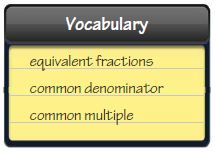
Question 1.
A ________ is a number that is a multiple of two or more numbers.
________
Answer: Common Multiple
A Common Multiple is a number that is a multiple of two or more numbers.
Question 2.
A ________ is a common multiple of two or more denominators.
________
Answer: Common denominator
A Common denominator is a common multiple of two or more denominators.
Concepts and Skills
Estimate the sum or difference.
Question 3.
\(\frac{8}{9}+\frac{4}{7}\)
about ______ \(\frac{□}{□}\)
Answer: 1 \(\frac{1}{2}\)
Place \(\frac{8}{9}\) on the number line.
\(\frac{8}{9}\) lies between \(\frac{1}{2}\) and 1.
\(\frac{8}{9}\) is closer to 1.
Place \(\frac{4}{7}\) on the number line.
\(\frac{4}{7}\) lies between \(\frac{1}{2}\) and 1.
\(\frac{4}{7}\) is closer to \(\frac{1}{2}\).
1 + \(\frac{1}{2}\) = 1 \(\frac{1}{2}\)
Question 4.
\(3 \frac{2}{5}-\frac{5}{8}\)
about ______
Answer: 3
Explanation:
Place \(\frac{2}{5}\) on the number line.
\(\frac{2}{5}\) lies between 0 and \(\frac{1}{2}\)
\(\frac{2}{5}\) is closer to \(\frac{1}{2}\)
Place \(\frac{5}{8}\) on the number line.
\(\frac{5}{8}\) lies between \(\frac{1}{2}\) and 1.
\(\frac{5}{8}\) is closer to \(\frac{1}{2}\)
3 + \(\frac{1}{2}\) – \(\frac{1}{2}\) = 3
\(3 \frac{2}{5}-\frac{5}{8}\) = 3
Question 5.
\(1 \frac{5}{6}+2 \frac{2}{11}\)
about ______
Answer: 4
Explanation:
Place \(\frac{5}{6}\) on the number line.
\(\frac{5}{6}\) lies between \(\frac{1}{2}\) and 1.
\(\frac{5}{6}\) is closer to 1.
Place \(\frac{2}{11}\) on the number line.
\(\frac{2}{11}\) lies between \(\frac{1}{2}\) and 0.
\(\frac{2}{11}\) is closer to 0
1 + 1 + 2 + 0 = 4
\(1 \frac{5}{6}+2 \frac{2}{11}\) = 4
Use a common denominator to write an equivalent fraction for each fraction.
Question 6.
\(\frac{1}{6}, \frac{1}{9}\)
common denominator:
Type below:
__________
Answer: 54
Multiply the denominators
6 × 9 = 54
Thus the common denominator of \(\frac{1}{6}, \frac{1}{9}\) is 54
Question 7.
\(\frac{3}{8}, \frac{3}{10}\)
common denominator:
Type below:
__________
Answer: 80
Multiply the denominators
8 × 10 = 80
The common denominator of \(\frac{3}{8}, \frac{3}{10}\) is 80
Question 8.
\(\frac{1}{9}, \frac{5}{12}\)
common denominator:
Type below:
__________
Answer: 36
Multiply the denominators
9 × 12 = 108
The common denominator of \(\frac{1}{9}, \frac{5}{12}\) is 108
Use the least common denominator to write an equivalent fraction for each fraction.
Question 9.
\(\frac{2}{5}, \frac{1}{10}\)
least common denominator: ______
Explain:
__________
Answer: 10
Explanation:
Multiply the denominators
5 × 10 = 50
The least common denominators of \(\frac{2}{5}, \frac{1}{10}\) is 10.
Question 10.
\(\frac{5}{6}, \frac{3}{8}\)
least common denominator: ______
Explain:
__________
Answer: 24
Explanation:
Multiply the denominators
The least common denominator of 6 and 8 is 24
Thus the LCD of \(\frac{5}{6}, \frac{3}{8}\) is 24
Question 11.
\(\frac{1}{3}, \frac{2}{7}\)
least common denominator: ______
Explain:
__________
Answer: 21
Explanation:
Multiply the denominators
The least common denominator of 3 and 7 is 21.
Thus the LCD of \(\frac{1}{3}, \frac{2}{7}\) is 21.
Find the sum or difference. Write your answer in simplest form.
Question 12.
\(\frac{11}{18}-\frac{1}{6}\)
\(\frac{□}{□}\)
Answer: \(\frac{8}{18}\)
Explanation:
Make the fractions like denominators.
\(\frac{11}{18}\) – \(\frac{1}{6}\)
\(\frac{1}{6}\) × \(\frac{3}{3}\) = \(\frac{3}{18}\)
\(\frac{11}{18}\) – \(\frac{3}{18}\) = \(\frac{8}{18}\)
Question 13.
\(\frac{2}{7}+\frac{2}{5}\)
\(\frac{□}{□}\)
Answer: \(\frac{24}{35}\)
Explanation:
Make the fractions like denominators.
\(\frac{2}{7}\) × \(\frac{5}{5}\) = \(\frac{10}{35}\)
\(\frac{2}{5}\) × \(\frac{7}{7}\) = \(\frac{14}{35}\)
\(\frac{10}{35}\) + \(\frac{14}{35}\) = \(\frac{24}{35}\)
Thus \(\frac{2}{7}+\frac{2}{5}\) = \(\frac{24}{35}\)
Question 14.
\(\frac{3}{4}-\frac{3}{10}\)
\(\frac{□}{□}\)
Answer: \(\frac{18}{40}\)
Explanation:
Make the fractions like denominators.
\(\frac{3}{4}\) × \(\frac{10}{10}\) = \(\frac{30}{40}\)
\(\frac{3}{10}\) × \(\frac{4}{4}\) = \(\frac{12}{40}\)
\(\frac{30}{40}\) – \(\frac{12}{40}\) = \(\frac{18}{40}\)
Mid-Chapter Checkpoint – Page No. 264
Question 15.
Mrs. Vargas bakes a pie for her book club meeting. The shaded part of the diagram below shows the amount of pie left after the meeting. That evening, Mr. Vargas eats \(\frac{1}{4}\) of the whole pie. What fraction represents the amount of pie remaining?
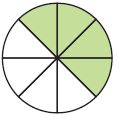
\(\frac{□}{□}\)
Answer: \(\frac{1}{4}\)
Explanation:
Mrs. Vargas bakes a pie for her book club meeting. The shaded part of the diagram below shows the amount of pie left after the meeting.
So, the fraction of the pie is \(\frac{1}{2}\)
That evening, Mr. Vargas eats \(\frac{1}{4}\) of the whole pie.
\(\frac{1}{2}\) – \(\frac{1}{4}\) = \(\frac{1}{4}\)
Thus the fraction represents the amount of pie remaining is \(\frac{1}{4}\)
Question 16.
Keisha makes a large sandwich for a family picnic. She takes \(\frac{1}{2}\) of the sandwich to the picnic. At the picnic, her family eats \(\frac{3}{8}\) of the whole sandwich. What fraction of the whole sandwich does Keisha bring back from the picnic?
\(\frac{□}{□}\)
Answer: \(\frac{1}{8}\)
Explanation:
Keisha makes a large sandwich for a family picnic. She takes \(\frac{1}{2}\) of the sandwich to the picnic.
At the picnic, her family eats \(\frac{3}{8}\) of the whole sandwich.
\(\frac{1}{2}\) – \(\frac{3}{8}\)
\(\frac{1}{2}\) × \(\frac{4}{4}\) – \(\frac{3}{8}\)
\(\frac{4}{8}\) – \(\frac{3}{8}\) = \(\frac{1}{8}\)
Thus Keisha brought \(\frac{1}{8}\) of the sandwich from the picnic.
Question 17.
Mike is mixing paint for his walls. He mixes \(\frac{1}{6}\) gallon blue paint and \(\frac{5}{8}\) gallon green paint in a large container. What fraction represents the total amount of paint Mike mixes?
\(\frac{□}{□}\)
Answer: \(\frac{19}{24}\)
Explanation:
Mike is mixing paint for his walls. He mixes \(\frac{1}{6}\) gallon blue paint and \(\frac{5}{8}\) gallon green paint in a large container.
\(\frac{1}{6}\) + \(\frac{5}{8}\)
\(\frac{1}{6}\) × \(\frac{8}{8}\) + \(\frac{5}{8}\) × \(\frac{6}{6}\)
\(\frac{8}{48}\) + \(\frac{30}{48}\)
\(\frac{38}{48}\) = \(\frac{19}{24}\)
Therefore the total amount of paint Mike mixes is \(\frac{19}{24}\)
Share and Show – Page No. 266
Question 1.
Use a common denominator to write equivalent fractions with like denominators and then find the sum. Write your answer in simplest form.
7 \(\frac{2}{5}\) = ■
+ 4 \(\frac{3}{4}\) = + ■
—————————
■
_____ \(\frac{□}{□}\)
Answer: 12 \(\frac{3}{20}\)
Explanation:
First convert the mixed fraction to proper fraction.
7 \(\frac{2}{5}\) = \(\frac{37}{5}\)
4 \(\frac{3}{4}\) = \(\frac{19}{4}\)
\(\frac{37}{5}\) + \(\frac{19}{4}\)
= \(\frac{37}{5}\) × \(\frac{4}{4}\) = \(\frac{148}{20}\)
\(\frac{19}{4}\) × \(\frac{5}{5}\) = \(\frac{95}{20}\)
\(\frac{148}{20}\) + \(\frac{95}{20}\) = \(\frac{243}{20}\)
Now convert it into mixed fraction = 12 \(\frac{3}{20}\)
Find the sum. Write your answer in simplest form.
Question 2.
\(2 \frac{3}{4}+3 \frac{3}{10}\)
_____ \(\frac{□}{□}\)
Answer: 6 \(\frac{1}{20}\)
Explanation:
First convert the mixed fraction to proper fraction.
\(2 \frac{3}{4}\) = \(\frac{11}{4}\)
3 \(\frac{3}{10}\) = \(\frac{33}{10}\)
Now make the common denominators of the above fractions.
\(\frac{11}{4}\) × \(\frac{10}{10}\) = \(\frac{110}{40}\)
\(\frac{33}{10}\) × \(\frac{4}{4}\) = \(\frac{132}{40}\) = \(\frac{121}{20}\)
Now convert the fraction into mixed fraction.
\(\frac{121}{20}\) = 6 \(\frac{1}{20}\)
Question 3.
\(5 \frac{3}{4}+1 \frac{1}{3}\)
_____ \(\frac{□}{□}\)
Answer: 7 \(\frac{1}{12}\)
Explanation:
First convert the mixed fraction to proper fraction.
5 \(\frac{3}{4}\) = \(\frac{23}{4}\)
1 \(\frac{1}{3}\) = \(\frac{4}{3}\)
\(\frac{23}{4}\) + \(\frac{4}{3}\)
\(\frac{23}{4}\) × \(\frac{3}{3}\) = \(\frac{69}{12}\)
\(\frac{4}{3}\) × \(\frac{4}{4}\) = \(\frac{16}{12}\)
\(\frac{69}{12}\) + \(\frac{16}{12}\) = \(\frac{85}{12}\)
The mixed fraction of \(\frac{85}{12}\) = 7 \(\frac{1}{12}\)
Question 4.
\(3 \frac{4}{5}+2 \frac{3}{10}\)
_____ \(\frac{□}{□}\)
Answer: 6 \(\frac{1}{10}\)
Explanation:
First convert the mixed fraction to proper fraction.
3 \(\frac{4}{5}\) = \(\frac{19}{5}\)
2 \(\frac{3}{10}\) = \(\frac{23}{10}\)
\(\frac{19}{5}\) + \(\frac{23}{10}\)
Now make the common denominators of the above fractions.
\(\frac{19}{5}\) × \(\frac{2}{2}\) = \(\frac{38}{10}\)
\(\frac{38}{10}\) + \(\frac{23}{10}\) = \(\frac{61}{10}\)
The mixed fraction of \(\frac{61}{10}\) = 6 \(\frac{1}{10}\)
Page No. 267
Find the difference. Write your answer in simplest form.
Question 5.
\(9 \frac{5}{6}-2 \frac{1}{3}\)
_____ \(\frac{□}{□}\)
Answer: 7 \(\frac{1}{2}\)
Explanation:
\(9 \frac{5}{6}-2 \frac{1}{3}\) = \(\frac{59}{6}\) – \(\frac{14}{6}\)
= \(\frac{45}{6}\) = \(\frac{15}{2}\) = 7 \(\frac{1}{2}\)
Question 6.
\(10 \frac{5}{9}-9 \frac{1}{6}\)
_____ \(\frac{□}{□}\)
Answer: 1 \(\frac{7}{18}\)
Explanation:
\(10 \frac{5}{9}-9 \frac{1}{6}\) = \(\frac{95}{9}\) – \(\frac{55}{6}\)
= \(\frac{190}{18}\) – \(\frac{165}{18}\) = \(\frac{25}{18}\)
= 1 \(\frac{7}{18}\)
\(10 \frac{5}{9}-9 \frac{1}{6}\) = 1 \(\frac{7}{18}\)
Question 7.
\(7 \frac{2}{3}-3 \frac{1}{6}\)
_____ \(\frac{□}{□}\)
Answer: 4 \(\frac{1}{2}\)
Explanation:
\(7 \frac{2}{3}-3 \frac{1}{6}\)
\(\frac{23}{3}\) – \(\frac{19}{6}\) = \(\frac{46}{6}\) – \(\frac{19}{6}\)
= \(\frac{27}{6}\) = 4 \(\frac{1}{2}\)
\(7 \frac{2}{3}-3 \frac{1}{6}\) = 4 \(\frac{1}{2}\)
On Your Own
Find the sum or difference. Write your answer in simplest form.
Question 8.
\(1 \frac{3}{10}+2 \frac{2}{5}\)
_____ \(\frac{□}{□}\)
Answer: 3 \(\frac{7}{10}\)
Explanation:
\(1 \frac{3}{10}+2 \frac{2}{5}\)
\(\frac{13}{10}\) + \(\frac{12}{5}\) = \(\frac{13}{10}\) + \(\frac{24}{10}\)
= \(\frac{37}{10}\) = 3 \(\frac{7}{10}\)
Thus \(1 \frac{3}{10}+2 \frac{2}{5}\) = 3 \(\frac{7}{10}\)
Question 9.
\(3 \frac{4}{9}+3 \frac{1}{2}\)
_____ \(\frac{□}{□}\)
Answer: 6 \(\frac{17}{18}\)
Explanation:
\(3 \frac{4}{9}+3 \frac{1}{2}\)
\(\frac{31}{9}\) + \(\frac{7}{2}\) = \(\frac{62}{18}\) + \(\frac{63}{18}\)
\(\frac{125}{18}\) = 6 \(\frac{17}{18}\)
\(3 \frac{4}{9}+3 \frac{1}{2}\) = 6 \(\frac{17}{18}\)
Question 10.
\(2 \frac{1}{2}+2 \frac{1}{3}\)
_____ \(\frac{□}{□}\)
Answer: 4 \(\frac{5}{6}\)
Explanation:
\(2 \frac{1}{2}+2 \frac{1}{3}\) = \(\frac{5}{2}\) + \(\frac{7}{3}\)
\(\frac{15}{6}\) + \(\frac{14}{6}\)= \(\frac{29}{6}\)
The mixed fraction of \(\frac{29}{6}\) is 4 \(\frac{5}{6}\)
Question 11.
\(5 \frac{1}{4}+9 \frac{1}{3}\)
_____ \(\frac{□}{□}\)
Answer: 14 \(\frac{7}{12}\)
Explanation:
\(5 \frac{1}{4}+9 \frac{1}{3}\) = \(\frac{21}{4}\) + \(\frac{28}{3}\)
\(\frac{63}{12}\) + \(\frac{112}{12}\) = \(\frac{175}{12}\)
The mixed fraction of \(\frac{175}{12}\) is 14 \(\frac{7}{12}\)
Question 12.
\(8 \frac{1}{6}+7 \frac{3}{8}\)
_____ \(\frac{□}{□}\)
Answer: 15 \(\frac{13}{24}\)
Explanation:
\(8 \frac{1}{6}+7 \frac{3}{8}\) = \(\frac{49}{6}\) + \(\frac{59}{8}\)
\(\frac{196}{24}\) + \(\frac{177}{24}\) = \(\frac{373}{24}\)
The mixed fraction of \(\frac{373}{24}\) is 15 \(\frac{13}{24}\)
Question 13.
\(14 \frac{7}{12}-5 \frac{1}{4}\)
_____ \(\frac{□}{□}\)
Answer: 9 \(\frac{1}{3}\)
Explanation:
\(14 \frac{7}{12}-5 \frac{1}{4}\) = \(\frac{175}{12}\) – \(\frac{21}{4}\)
\(\frac{175}{12}\) – \(\frac{63}{12}\) = \(\frac{112}{12}\)
The mixed fraction of \(\frac{112}{12}\) is 9 \(\frac{1}{3}\)
Question 14.
\(12 \frac{3}{4}-6 \frac{1}{6}\)
_____ \(\frac{□}{□}\)
Answer: 6 \(\frac{7}{12}\)
Explanation:
\(12 \frac{3}{4}-6 \frac{1}{6}\) = \(\frac{51}{4}\) – \(\frac{37}{6}\)
\(\frac{153}{12}\) – \(\frac{74}{12}\) = \(\frac{79}{12}\)
The mixed fraction of \(\frac{79}{12}\) is 6 \(\frac{7}{12}\)
Question 15.
\(2 \frac{5}{8}-1 \frac{1}{4}\)
_____ \(\frac{□}{□}\)
Answer: 1 \(\frac{3}{8}\)
Explanation:
\(2 \frac{5}{8}-1 \frac{1}{4}\)
\(\frac{21}{8}\) – \(\frac{5}{4}\) = \(\frac{21}{8}\) – \(\frac{10}{8}\)
= \(\frac{11}{8}\)
The mixed fraction of \(\frac{11}{8}\) is 1 \(\frac{3}{8}\)
Question 16.
\(10 \frac{1}{2}-2 \frac{1}{5}\)
_____ \(\frac{□}{□}\)
Answer: 8 \(\frac{3}{10}\)
Explanation:
\(10 \frac{1}{2}-2 \frac{1}{5}\) = \(\frac{21}{2}\) – \(\frac{11}{5}\)
\(\frac{105}{10}\) – \(\frac{22}{10}\) = \(\frac{83}{10}\)
The mixed fraction of \(\frac{83}{10}\) is 8 \(\frac{3}{10}\)
Practice: Copy and Solve Find the sum or difference. Write your answer in simplest form.
Question 17.
\(1 \frac{5}{12}+4 \frac{1}{6}\)
_____ \(\frac{□}{□}\)
Answer: 5 \(\frac{7}{12}\)
Explanation:
\(1 \frac{5}{12}+4 \frac{1}{6}\) = \(\frac{17}{12}\) + \(\frac{25}{6}\)
\(\frac{17}{12}\) + \(\frac{50}{12}\) = \(\frac{67}{12}\)
The mixed fraction of \(\frac{67}{12}\) is 5 \(\frac{7}{12}\)
Question 18.
\(8 \frac{1}{2}+6 \frac{3}{5}\)
_____ \(\frac{□}{□}\)
Answer: 15 \(\frac{1}{10}\)
Explanation:
\(8 \frac{1}{2}+6 \frac{3}{5}\) = \(\frac{17}{2}\) + \(\frac{33}{5}\)
\(\frac{85}{10}\) + \(\frac{66}{10}\) = \(\frac{151}{10}\)
The mixed fraction of \(\frac{151}{10}\) is 15 \(\frac{1}{10}\)
\(8 \frac{1}{2}+6 \frac{3}{5}\) = 15 \(\frac{1}{10}\)
Question 19.
\(2 \frac{1}{6}+4 \frac{5}{9}\)
_____ \(\frac{□}{□}\)
Answer: 6 \(\frac{13}{18}\)
Explanation:
\(2 \frac{1}{6}+4 \frac{5}{9}\) = \(\frac{13}{6}\) + \(\frac{41}{9}\)
\(\frac{39}{18}\) + \(\frac{82}{18}\) = \(\frac{121}{18}\)
The mixed fraction of \(\frac{121}{18}\) is 6 \(\frac{13}{18}\)
\(2 \frac{1}{6}+4 \frac{5}{9}\) = 6 \(\frac{13}{18}\)
Question 20.
\(20 \frac{5}{8}+\frac{5}{12}\)
_____ \(\frac{□}{□}\)
Answer: 21 \(\frac{1}{24}\)
Explanation:
\(20 \frac{5}{8}+\frac{5}{12}\) = \(\frac{165}{8}\) + \(\frac{5}{12}\)
\(\frac{495}{24}\) + \(\frac{10}{24}\) = \(\frac{505}{24}\)
The mixed fraction of \(\frac{505}{24}\) is 21 \(\frac{1}{24}\)
\(20 \frac{5}{8}+\frac{5}{12}\) = 21 \(\frac{1}{24}\)
Question 21.
\(3 \frac{2}{3}-1 \frac{1}{6}\)
_____ \(\frac{□}{□}\)
Answer: 2 \(\frac{1}{2}\)
Explanation:
\(3 \frac{2}{3}-1 \frac{1}{6}\) = \(\frac{11}{3}\) – \(\frac{7}{6}\)
\(\frac{22}{6}\) – \(\frac{7}{6}\) = \(\frac{15}{6}\) = \(\frac{5}{2}\)
The mixed fraction of \(\frac{5}{2}\) is 2 \(\frac{1}{2}\)
\(3 \frac{2}{3}-1 \frac{1}{6}\) = 2 \(\frac{1}{2}\)
Question 22.
\(5 \frac{6}{7}-1 \frac{2}{3}\)
_____ \(\frac{□}{□}\)
Answer: 4 \(\frac{4}{21}\)
Explanation:
\(5 \frac{6}{7}-1 \frac{2}{3}\) = \(\frac{41}{7}\) – \(\frac{5}{3}\)
\(\frac{123}{21}\) – \(\frac{35}{21}\) = \(\frac{88}{21}\)
The mixed fraction of \(\frac{88}{21}\) is 4 \(\frac{4}{21}\)
Question 23.
\(2 \frac{7}{8}-\frac{1}{2}\)
_____ \(\frac{□}{□}\)
Answer: 2 \(\frac{3}{8}\)
Explanation:
\(2 \frac{7}{8}-\frac{1}{2}\) = \(\frac{23}{8}\) – \(\frac{1}{2}\)
= \(\frac{23}{8}\) – \(\frac{4}{8}\) = \(\frac{19}{8}\)
The mixed fraction of \(\frac{19}{8}\) is 2 \(\frac{3}{8}\)
So, \(2 \frac{7}{8}-\frac{1}{2}\) = 2 \(\frac{3}{8}\)
Question 24.
\(4 \frac{7}{12}-1 \frac{2}{9}\)
_____ \(\frac{□}{□}\)
Answer: 3 \(\frac{13}{36}\)
Explanation:
\(4 \frac{7}{12}-1 \frac{2}{9}\) = \(\frac{55}{12}\) – \(\frac{11}{9}\)
\(\frac{165}{36}\) – \(\frac{44}{36}\) = \(\frac{121}{36}\)
The mixed fraction of \(\frac{121}{36}\) is 3 \(\frac{13}{36}\)
Problem Solving – Page No. 268
Use the table to solve 25–28.
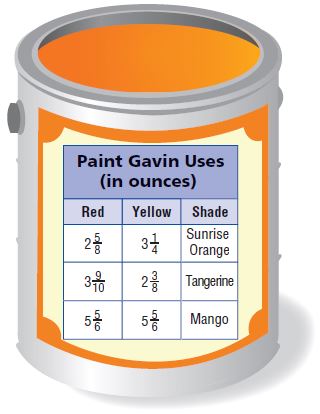
Question 25.
Gavin is mixing a batch of Sunrise Orange paint for an art project. How much paint does Gavin mix?
_____ \(\frac{□}{□}\) ounces
Answer: 5 \(\frac{7}{8}\) ounces
Explanation:
Gavin is mixing a batch of Sunrise Orange paint for an art project.
2 \(\frac{5}{8}\) + 3 \(\frac{1}{4}\)
Solving the whole numbers
2 + 3 = 5
Add the fraction parts
\(\frac{5}{8}\) + \(\frac{1}{4}\)
LCD = 8
\(\frac{5}{8}\) + \(\frac{2}{8}\) = \(\frac{7}{8}\)
5 + \(\frac{7}{8}\) = 5 \(\frac{7}{8}\) ounces
Question 26.
Gavin plans to mix a batch of Tangerine paint. He expects to have a total of 5 \(\frac{3}{10}\) ounces of paint after he mixes the amounts of red and yellow. Explain how you can tell if Gavin’s expectation is reasonable.
Type below:
_________
Answer:
Gavin plans to mix a batch of Tangerine paint. He expects to have a total of 5 \(\frac{3}{10}\) ounces of paint after he mixes the amounts of red and yellow.
To mix a batch of Tangerine paint he need 3 \(\frac{9}{10}\) red and 2 \(\frac{3}{8}\) yellow paint.
Add the fractions
3 + \(\frac{9}{10}\) + 2 + \(\frac{3}{8}\)
Solving the whole numbers
3 + 2 = 5
\(\frac{9}{10}\) + \(\frac{3}{8}\)
LCD = 40
\(\frac{9}{10}\) + \(\frac{3}{8}\) = \(\frac{36}{40}\) + \(\frac{15}{40}\) = \(\frac{51}{40}\) = 1 \(\frac{11}{40}\)
5 + 1 \(\frac{11}{40}\) = 6 \(\frac{11}{40}\)
Question 27.
For a special project, Gavin mixes the amount of red from one shade of paint with the amount of yellow from a different shade. He mixes the batch so he will have the greatest possible amount of paint. What amounts of red and yellow from which shades are used in the mixture for the special project? Explain your answer.
Type below:
_________
Answer:
Gavin used red paint from mango and yellow paint from Sunrise Orange.
5 \(\frac{5}{6}\) + 3 \(\frac{1}{4}\)
Solving the whole numbers parts
5 + 3 = 8
Solving the fraction part
\(\frac{5}{6}\) + \(\frac{1}{4}\)
LCD = 12
\(\frac{10}{12}\) + \(\frac{3}{12}\) = \(\frac{13}{12}\)
\(\frac{13}{12}\) = 1 \(\frac{1}{12}\)
Question 28.
Gavin needs to make 2 batches of Mango paint. Explain how you could find the total amount of paint Gavin mixed.
Type below:
_________
Answer:
Gavin used Red paint and Yellow Paint to make Mango shade.
For one batch he need to add 5 \(\frac{5}{6}\) + 5 \(\frac{5}{6}\)
Foe 2 batches
5 \(\frac{5}{6}\)+ 5 \(\frac{5}{6}\) + 5 \(\frac{5}{6}\) + 5 \(\frac{5}{6}\)
Solving the whole numbers
5 + 5 + 5 + 5 = 20
Solving the fractions part
\(\frac{5}{6}\) + \(\frac{5}{6}\) + \(\frac{5}{6}\) + \(\frac{5}{6}\) = \(\frac{20}{6}\)
= \(\frac{10}{3}\)
Gavin mixed \(\frac{10}{3}\) of paint to make 2 batches of Mango Paint.
Question 29.
Test Prep Yolanda walked 3 \(\frac{6}{10}\) miles. Then she walked 4 \(\frac{1}{2}\) more miles. How many miles did Yolanda walk?
Options:
a. 7 \(\frac{1}{10}\) miles
b. 7 \(\frac{7}{10}\) miles
c. 8 \(\frac{1}{10}\) miles
d. 8 \(\frac{7}{10}\) miles
Answer: 8 \(\frac{1}{10}\) miles
Explanation:
Test Prep Yolanda walked 3 \(\frac{6}{10}\) miles.
Then she walked 4 \(\frac{1}{2}\) more miles.
3 \(\frac{6}{10}\) + 4 \(\frac{1}{2}\) = 3 + \(\frac{6}{10}\) + 4 + \(\frac{1}{2}\)
Add whole numbers
3 + 4 = 7
Add the fractions
\(\frac{6}{10}\) + \(\frac{1}{2}\)
LCD = 10
\(\frac{6}{10}\) + \(\frac{5}{10}\) = \(\frac{11}{10}\)
\(\frac{11}{10}\) = 8 \(\frac{1}{10}\) miles
Thus the correct answer is option C.
Share and Show – Page No. 270
Estimate. Then find the difference and write it in simplest form.
Question 1.
Estimate: ______
1 \(\frac{3}{4}-\frac{7}{8}\)
Estimate: _____ \(\frac{□}{□}\)
Difference: _____ \(\frac{□}{□}\)
Answer:
Estimate: 1
Difference: \(\frac{7}{8}\)
Explanation:
Estimation: 1 + \(\frac{3}{4}\) – \(\frac{7}{8}\)
\(\frac{7}{8}\) is close to 1.
\(\frac{3}{4}\) is close to 1.
1 + 1 – 1 = 1
Difference: 1 \(\frac{3}{4}-\frac{7}{8}\)
1 + \(\frac{3}{4}\) – \(\frac{7}{8}\)
\(\frac{3}{4}\) – \(\frac{7}{8}\)
\(\frac{3}{4}\) × \(\frac{8}{8}\) – \(\frac{7}{8}\) × \(\frac{4}{4}\)
\(\frac{24}{32}\) – \(\frac{28}{32}\) = – \(\frac{1}{8}\)
1 – \(\frac{1}{8}\) = \(\frac{7}{8}\)
Question 2.
Estimate: ______
\(12 \frac{1}{9}-7 \frac{1}{3}\)
Estimate: _____ \(\frac{□}{□}\)
Difference: _____ \(\frac{□}{□}\)
Answer:
Estimate: 5
Difference: 4 \(\frac{7}{9}\)
Explanation:
Estimate: 12 + 0 – 7 – 0 = 5
Difference:
12 + \(\frac{1}{9}\) – 7 – \(\frac{1}{3}\)
12 – 7 = 5
\(\frac{1}{9}\) – \(\frac{1}{3}\) = \(\frac{1}{9}\) – \(\frac{3}{9}\) = – \(\frac{2}{9}\)
5 – \(\frac{2}{9}\) = 4 \(\frac{7}{9}\)
Page No. 271
Estimate. Then find the difference and write it in simplest form.
Question 3.
Estimate: ________
\(4 \frac{1}{2}-3 \frac{4}{5}\)
Estimate: _____ \(\frac{□}{□}\)
Difference: _____ \(\frac{□}{□}\)
Answer:
Estimate: \(\frac{1}{2}\)
Difference: \(\frac{7}{10}\)
Explanation:
\(4 \frac{1}{2}-3 \frac{4}{5}\)
4 – \(\frac{1}{2}\) – 3 – 1
= \(\frac{1}{2}\)
Difference:
\(4 \frac{1}{2}-3 \frac{4}{5}\)
4 \(\frac{1}{2}\) – 3 \(\frac{4}{5}\)
Solving the whole number parts
4 – 3 = 1
Solving the fraction parts
\(\frac{1}{2}\) – \(\frac{4}{5}\)
LCD = 10
\(\frac{5}{10}\) – \(\frac{8}{10}\) = – \(\frac{3}{10}\)
1 – \(\frac{3}{10}\) = \(\frac{7}{10}\)
Question 4.
Estimate: ________
\(9 \frac{1}{6}-2 \frac{3}{4}\)
Estimate: _____ \(\frac{□}{□}\)
Difference: _____ \(\frac{□}{□}\)
Answer:
Estimate: 6
Difference: 6 \(\frac{5}{12}\)
Explanation:
\(9 \frac{1}{6}-2 \frac{3}{4}\)
9 + 0 – 2 – 1 = 6
Difference:
\(9 \frac{1}{6}-2 \frac{3}{4}\)
9 + \(\frac{1}{6}\) – 2 – \(\frac{3}{4}\)
9 – 2 = 7
\(\frac{1}{6}\) – \(\frac{3}{4}\)
LCD = 12
\(\frac{2}{12}\) – \(\frac{9}{12}\) = – \(\frac{7}{12}\)
7 – \(\frac{7}{12}\) = 6 \(\frac{5}{12}\)
\(9 \frac{1}{6}-2 \frac{3}{4}\) = 6 \(\frac{5}{12}\)
On Your Own
Estimate. Then find the difference and write it in simplest form.
Question 5.
Estimate: ________
\(3 \frac{2}{3}-1 \frac{11}{12}\)
Estimate: _____ \(\frac{□}{□}\)
Difference: _____ \(\frac{□}{□}\)
Answer:
Estimate: 2
Difference: 1 \(\frac{3}{4}\)
Explanation:
Estimate:
\(3 \frac{2}{3}-1 \frac{11}{12}\)
\(\frac{2}{3}\) is close to 1.
\(\frac{11}{12}\) is close to 1.
3 + 1 – 1 – 1 = 2
Difference:
\(3 \frac{2}{3}-1 \frac{11}{12}\)
3 + \(\frac{2}{3}\) – 1 – \(\frac{11}{12}\)
3 – 1 = 2
Solving the fractions part
\(\frac{2}{3}\) – \(\frac{11}{12}\)
LCD = 12
\(\frac{8}{12}\) – \(\frac{11}{12}\) = – \(\frac{3}{12}\) = – \(\frac{1}{4}\)
3 – \(\frac{1}{4}\) = 1 \(\frac{3}{4}\)
\(3 \frac{2}{3}-1 \frac{11}{12}\) = 1 \(\frac{3}{4}\)
Question 6.
Estimate: ________
\(4 \frac{1}{4}-2 \frac{1}{3}\)
Estimate: _____ \(\frac{□}{□}\)
Difference: _____ \(\frac{□}{□}\)
Answer:
Estimate: 2
Difference: 1 \(\frac{11}{12}\)
Explanation:
\(4 \frac{1}{4}-2 \frac{1}{3}\)
\(\frac{1}{4}\) is close to 0.
\(\frac{1}{3}\) is close to 0.
4 – 2 = 2
Solving the fractions part
\(\frac{1}{4}\) – \(\frac{1}{3}\)
LCD = 12
\(\frac{1}{4}\) × \(\frac{3}{3}\) – \(\frac{1}{3}\) × \(\frac{4}{4}\)
\(\frac{3}{12}\) – \(\frac{4}{12}\) = – \(\frac{1}{12}\)
2 – \(\frac{1}{12}\) = 1 \(\frac{11}{12}\)
Question 7.
Estimate: ________
\(5 \frac{2}{5}-1 \frac{1}{2}\)
Estimate: _____ \(\frac{□}{□}\)
Difference: _____ \(\frac{□}{□}\)
Answer:
Estimate: 4
Difference: 3 \(\frac{9}{10}\)
Explanation:
Estimate:
\(5 \frac{2}{5}-1 \frac{1}{2}\)
5 + \(\frac{1}{2}\) – 1 – \(\frac{1}{2}\)
5 – 1 = 4
Solving the fractions part
\(5 \frac{2}{5}-1 \frac{1}{2}\)
LCD = 10
\(\frac{4}{10}\) – \(\frac{5}{10}\) = – \(\frac{1}{10}\)
4 – \(\frac{1}{10}\) = 3 \(\frac{9}{10}\)
Question 8.
\(7 \frac{5}{9}-2 \frac{5}{6}\)
Estimate: _____ \(\frac{□}{□}\)
Difference: _____ \(\frac{□}{□}\)
Answer:
Estimate: 4 \(\frac{1}{2}\)
Difference: 4 \(\frac{13}{18}\)
Explanation:
Estimate:
\(7 \frac{5}{9}-2 \frac{5}{6}\)
\(\frac{5}{9}\) is close to \(\frac{1}{2}\)
\(\frac{5}{6}\) is close to 1.
7 + \(\frac{1}{2}\) – 2 – 1
4 \(\frac{1}{2}\)
Difference:
\(7 \frac{5}{9}-2 \frac{5}{6}\)
7 + \(\frac{5}{9}\) – 2 – \(\frac{5}{6}\)
Solving the whole numbers
7 – 2 = 5
Solving the fraction part
\(\frac{5}{9}\) – \(\frac{5}{6}\)
LCD = 18
\(\frac{10}{18}\) – \(\frac{15}{18}\) = – \(\frac{5}{18}\)
5 – \(\frac{5}{18}\) = 4 \(\frac{13}{18}\)
Question 9.
Estimate: ________
\(7-5 \frac{2}{3}\)
Estimate: _____ \(\frac{□}{□}\)
Difference: _____ \(\frac{□}{□}\)
Answer:
Estimate: 1
Difference: 1 \(\frac{1}{3}\)
Explanation:
Estimate:
\(7-5 \frac{2}{3}\)
7 – 5 – \(\frac{2}{3}\)
7 – 5 – 1 = 1
Difference:
\(7-5 \frac{2}{3}\)
7 – 5 = 2
2 – \(\frac{2}{3}\) = 1 \(\frac{1}{3}\)
Thus \(7-5 \frac{2}{3}\) = 1 \(\frac{1}{3}\)
Question 10.
Estimate: ________
\(2 \frac{1}{5}-1 \frac{9}{10}\)
Estimate: _____ \(\frac{□}{□}\)
Difference: _____ \(\frac{□}{□}\)
Answer:
Estimate: 0
Difference: \(\frac{3}{10}\)
Explanation:
Estimate:
\(2 \frac{1}{5}-1 \frac{9}{10}\)
2 + 0 – 1 – 1 = 0
Difference:
\(2 \frac{1}{5}-1 \frac{9}{10}\)
2 \(\frac{1}{5}\) – 1 \(\frac{9}{10}\)
2 + \(\frac{1}{5}\) – 1 – \(\frac{9}{10}\)
Solving the whole number parts
2 – 1 = 1
\(\frac{1}{5}\) – \(\frac{9}{10}\)
LCD = 10
\(\frac{2}{10}\) – \(\frac{9}{10}\) = – \(\frac{7}{10}\)
1 – \(\frac{7}{10}\) = \(\frac{3}{10}\)
Practice: Copy and Solve Find the difference and write it in simplest form.
Question 11.
\(11 \frac{1}{9}-3 \frac{2}{3}\)
_____ \(\frac{□}{□}\)
Answer: 7 \(\frac{4}{9}\)
Explanation:
Rewriting our equation with parts separated
11 + \(\frac{1}{9}\) – 3 – \(\frac{2}{3}\)
Solving the whole number parts
11 – 3 = 8
Solving the fraction parts
LCD = 9
\(\frac{1}{9}\) – \(\frac{2}{3}\)
\(\frac{1}{9}\) – \(\frac{6}{9}\) = – \(\frac{5}{9}\)
8 – \(\frac{5}{9}\) = 7 \(\frac{4}{9}\)
Question 12.
\(6-3 \frac{1}{2}\)
_____ \(\frac{□}{□}\)
Answer: 2 \(\frac{1}{2}\)
Explanation:
Rewriting our equation with parts separated
6 – 3 – \(\frac{1}{2}\)
3 – \(\frac{1}{2}\) = 2 \(\frac{1}{2}\)
Question 13.
\(4 \frac{3}{8}-3 \frac{1}{2}\)
\(\frac{□}{□}\)
Answer: \(\frac{7}{8}\)
Explanation:
Rewriting our equation with parts separated
4 + \(\frac{3}{8}\) – 3 – \(\frac{1}{2}\)
Solving the whole number parts
4 – 3 = 1
Solving the fraction parts
\(\frac{3}{8}\) – \(\frac{1}{2}\) = \(\frac{3}{8}\) – \(\frac{4}{8}\)
= – \(\frac{1}{8}\)
1 – \(\frac{1}{8}\) = \(\frac{7}{8}\)
Question 14.
\(9 \frac{1}{6}-3 \frac{5}{8}\)
_____ \(\frac{□}{□}\)
Answer: 5 \(\frac{13}{24}\)
Explanation:
Rewriting our equation with parts separated
9 + \(\frac{1}{6}\) – 3 – \(\frac{5}{8}\)
Solving the whole number parts
9 – 3 = 6
Solving the fraction parts
\(\frac{1}{6}\) – \(\frac{5}{8}\)
\(\frac{4}{24}\) – \(\frac{15}{24}\) = – \(\frac{11}{24}\)
6 – \(\frac{11}{24}\) = 5 \(\frac{13}{24}\)
Question 15.
\(1 \frac{1}{5}-\frac{1}{2}\)
\(\frac{□}{□}\)
Answer: \(\frac{7}{10}\)
Explanation:
Rewriting our equation with parts separated
1 + \(\frac{1}{5}\) – \(\frac{1}{2}\)
Solving the whole number parts
1 + 0 = 1
Solving the fraction parts
\(\frac{1}{5}\) – \(\frac{1}{2}\)
LCD = 10
\(\frac{2}{10}\) – \(\frac{5}{10}\) = – \(\frac{3}{10}\)
1 – \(\frac{3}{10}\) = \(\frac{7}{10}\)
Question 16.
\(13 \frac{1}{6}-3 \frac{4}{5}\)
_____ \(\frac{□}{□}\)
Answer: 9 \(\frac{11}{30}\)
Explanation:
Rewriting our equation with parts separated
13 + \(\frac{1}{6}\) – 3 – \(\frac{4}{5}\)
Solving the whole number parts
13 – 3 = 10
Solving the fraction parts
\(\frac{1}{6}\) – \(\frac{4}{5}\)
LCD = 30
\(\frac{5}{30}\) – \(\frac{24}{30}\) = – \(\frac{19}{30}\)
10 – \(\frac{19}{30}\) = 9 \(\frac{11}{30}\)
Question 17.
\(12 \frac{2}{5}-5 \frac{3}{4}\)
_____ \(\frac{□}{□}\)
Answer: 6 \(\frac{13}{20}\)
Explanation:
Rewriting our equation with parts separated
12 + \(\frac{2}{5}\) – 5 – \(\frac{3}{4}\)
Solving the whole number parts
12 – 5 = 7
Solving the fraction parts
\(\frac{2}{5}\) – \(\frac{3}{4}\)
LCD = 20
\(\frac{8}{20}\) – \(\frac{15}{20}\) = – \(\frac{7}{20}\)
7 – \(\frac{7}{20}\) = 6 \(\frac{13}{20}\)
Question 18.
\(7 \frac{3}{8}-2 \frac{7}{9}\)
_____ \(\frac{□}{□}\)
Answer: 4 \(\frac{43}{72}\)
Explanation:
7 + \(\frac{3}{8}\) – 2 – \(\frac{7}{9}\)
7 – 2 = 5
\(\frac{3}{8}\) – \(\frac{7}{9}\) = \(\frac{27}{72}\) – \(\frac{56}{72}\)
– \(\frac{29}{72}\)
5 – \(\frac{29}{72}\) = 4 \(\frac{43}{72}\)
Page No. 272
Connect to Reading
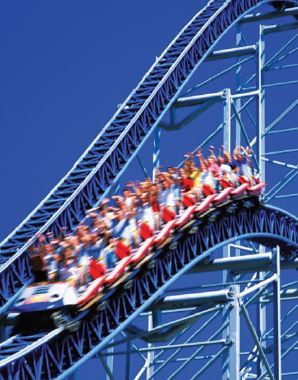
Summarize
An amusement park in Sandusky, Ohio, offers 17 amazing roller coasters for visitors to ride. One of the roller coasters runs at 60 miles per hour and has 3,900 feet of twisting track. This coaster also has 3 trains with 8 rows per train. Riders stand in rows of 4, for a total of 32 riders per train.
The operators of the coaster recorded the number of riders on each train during a run. On the first train, the operators reported that 7 \(\frac{1}{4}\) rows were filled. On the second train, all 8 rows were filled, and on the third train, 5 \(\frac{1}{2}\) rows were filled. How many more rows were filled on the first train than on the third train?
When you summarize, you restate the most important information in a shortened form to more easily understand what you have read.
Summarize the information given.
______________________
Use the summary to solve.
Question 19.
Solve the problem above.
Type below:
_________
Answer:
On the first train, the operators reported that 7 \(\frac{1}{4}\) rows were filled.
On the third train, 5 \(\frac{1}{2}\) rows were filled.
7 \(\frac{1}{4}\) – 5 \(\frac{1}{2}\)
Solving the whole numbers
7 – 5 = 2
Solving the fractions
\(\frac{1}{4}\) – \(\frac{1}{2}\) = – \(\frac{1}{4}\)
2 – \(\frac{1}{4}\) = 1 \(\frac{3}{4}\)
1 \(\frac{3}{4}\) more rows were filled on the first train than on the third train.
Question 20.
How many rows were empty on the third train? How many additional riders would it take to fill the empty rows? Explain your answer.
Type below:
_________
Answer:
The coaster also has 3 trains with 8 rows per train.
The third train has 8 rows.
On the third train, 5 \(\frac{1}{2}\) rows were filled.
8 – 5 \(\frac{1}{2}\)
8 – 5 – \(\frac{1}{2}\) = 2 \(\frac{1}{2}\)
2 \(\frac{1}{2}\) rows are empty.
So, it takes 10 additional riders to fill the empty rows on the third train.
Share and Show – Page No. 275
Write a rule for the sequence.
Question 1.
\(\frac{1}{4}, \frac{1}{2}, \frac{3}{4}, \cdots\)
Think: Is the sequence increasing or decreasing?
Rule: _________
Type below:
_________
Answer: The sequence is increasing order with difference \(\frac{1}{4}\)
Question 2.
\(\frac{1}{9}, \frac{1}{3}, \frac{5}{9}, \ldots\)
Type below:
_________
Answer: The sequence is increasing order with difference 2 in numerataor.
Write a rule for the sequence. Then, find the unknown term.
Question 3.
\(\frac{3}{10}, \frac{2}{5}\), \(\frac{□}{□}\) , \(\frac{3}{5}, \frac{7}{10}\)
Answer: The sequence is increasing order with difference \(\frac{1}{2}\)
LCD = 10
Add \(\frac{1}{2}\) to each term
Let the unknown fraction be x
\(\frac{3}{10}\), \(\frac{4}{10}\), x, \(\frac{6}{10}\), \(\frac{7}{10}\)
x = \(\frac{5}{10}\) = \(\frac{1}{2}\)
Question 4.
\(10 \frac{2}{3}, 9 \frac{11}{18}, 8 \frac{5}{9}\), ______ \(\frac{□}{□}\) , \(6 \frac{4}{9}\)
Answer: 7 \(\frac{1}{2}\)
Explanation:
\(\frac{32}{3}\), \(\frac{173}{18}\), \(\frac{77}{9}\), x, \(\frac{58}{9}\)
LCD = 54
\(\frac{576}{54}\), \(\frac{519}{54}\), \(\frac{462}{54}\), x, \(\frac{348}{54}\)
According to the series x = \(\frac{405}{54}\) = \(\frac{15}{2}\)
The mixed fraction of \(\frac{15}{2}\) is 7 \(\frac{1}{2}\)
Question 5.
\(1 \frac{1}{6}\), ______ \(\frac{□}{□}\) , \(1, \frac{11}{12}, \frac{5}{6}\)
Answer: 1 \(\frac{1}{12}\)
Explanation:
\(1 \frac{1}{6}\), ______ \(\frac{□}{□}\) , \(1, \frac{11}{12}, \frac{5}{6}\)
The LCD of the above fractons is 12
Convert them into improper fractions
\(\frac{14}{12}\), x, \(\frac{12}{12}\), \(\frac{11}{12}\), \(\frac{10}{12}\)
According to the series x = \(\frac{13}{12}\)
The mixed fraction of \(\frac{13}{12}\) is 1 \(\frac{1}{12}\)
Question 6.
\(2 \frac{3}{4}, 4,5 \frac{1}{4}, 6 \frac{1}{2}\), ______ \(\frac{□}{□}\)
Answer: 7 \(\frac{3}{4}\)
Explanation:
\(2 \frac{3}{4}, 4,5 \frac{1}{4}, 6 \frac{1}{2}\), ______ \(\frac{□}{□}\)
Convert the mixed fractions into improper fractions
\(\frac{11}{4}\), \(\frac{4}{1}\), \(\frac{21}{4}\), \(\frac{13}{2}\), x
\(\frac{11}{4}\), \(\frac{16}{4}\), \(\frac{21}{4}\), \(\frac{26}{4}\), x
According to the series x = \(\frac{31}{4}\)
The mixed fraction of \(\frac{31}{4}\) is 7 \(\frac{3}{4}\)
On Your Own
Write a rule for the sequence. Then, find the unknown term.
Question 7.
\(\frac{1}{8}, \frac{1}{2}\), \(\frac{□}{□}\) , \(1 \frac{1}{4}, 1 \frac{5}{8}\)
Answer: \(\frac{7}{8}\)
Explanation:
\(\frac{1}{8}, \frac{1}{2}\), \(1 \frac{1}{4}, 1 \frac{5}{8}\), x
LCD = 8
\(\frac{1}{8}, \frac{4}{8}\), \(\frac{10}{8}, \frac{26}{8}\), x
\(\frac{1}{8}\), \(\frac{4}{8}\), x, \(\frac{10}{8}\), \(\frac{26}{8}\)
The difference between the series is 3 in numerator.
x = \(\frac{7}{8}\)
Question 8.
\(1 \frac{2}{3}, 1 \frac{3}{4}, 1 \frac{5}{6}, 1 \frac{11}{12}\), ______
Answer: 2
Explanation:
1 \(\frac{2}{3}\), 1 \(\frac{3}{4}\), 1 \(\frac{5}{6}\), 1 \(\frac{11}{12}\)
Convert the mixed fractions into improper fractions
\(\frac{5}{3}\), \(\frac{7}{4}\), \(\frac{11}{6}\), \(\frac{23}{12}\), x
The LCD is 12
\(\frac{20}{12}\), \(\frac{21}{12}\), \(\frac{22}{12}\), \(\frac{23}{12}\), x
x = \(\frac{24}{12}\) = 2
Question 9.
\(12 \frac{7}{8}, 10 \frac{3}{4}\), ______ \(\frac{□}{□}\) , \(6 \frac{1}{2}, 4 \frac{3}{8}\)
Answer: 8 \(\frac{5}{8}\)
Explanation:
\(12 \frac{7}{8}, 10 \frac{3}{4}\), x , \(6 \frac{1}{2}, 4 \frac{3}{8}\)
Convert the mixed fractions into improper fractions
\(\frac{103}{8}\), \(\frac{43}{4}\), x, \(\frac{13}{2}\), \(\frac{35}{8}\)
The LCD is 8
\(\frac{103}{8}\), \(\frac{86}{8}\), x, \(\frac{52}{8}\), \(\frac{35}{8}\)
x = \(\frac{69}{8}\)
The mixed fraction of \(\frac{69}{8}\) is 8 \(\frac{5}{8}\)
Question 10.
\(9 \frac{1}{3}\), ______ \(\frac{□}{□}\) , \(6 \frac{8}{9}, 5 \frac{2}{3}, 4 \frac{4}{9}\)
Answer: 8 \(\frac{1}{9}\)
Explanation:
\(9 \frac{1}{3}\), x , \(6 \frac{8}{9}, 5 \frac{2}{3}, 4 \frac{4}{9}\)
Convert the mixed fractions into improper fractions
\(\frac{28}{3}\), x, \(\frac{62}{9}\), \(\frac{17}{3}\), \(\frac{40}{9}\)
LCD = 9
\(\frac{84}{9}\), x, \(\frac{62}{9}\), \(\frac{51}{9}\), \(\frac{40}{9}\)
According to the series x = \(\frac{73}{9}\) = 8 \(\frac{1}{9}\)
Write the first four terms of the sequence.
Question 11.
Rule: start at 5 \(\frac{3}{4}\), subtract \(\frac{5}{8}\)
First term: ______ \(\frac{□}{□}\)
Second term: ______ \(\frac{□}{□}\)
Third term: ______ \(\frac{□}{□}\)
Fourth term: ______ \(\frac{□}{□}\)
Answer:
Let the first term be 5 \(\frac{3}{4}\)
Second term = 5 \(\frac{3}{4}\) – \(\frac{5}{8}\) = \(\frac{41}{8}\) = 5 \(\frac{1}{8}\)
Third term = 5 \(\frac{1}{8}\) – \(\frac{5}{8}\) = \(\frac{36}{8}\) = 4 \(\frac{1}{2}\)
Fourth term = \(\frac{36}{8}\) – \(\frac{5}{8}\) = \(\frac{31}{8}\) = 3 \(\frac{7}{8}\)
Question 12.
Rule: start at \(\frac{3}{8}\), add \(\frac{3}{16}\)
Type below:
_________
Answer:
Let the first term be \(\frac{3}{8}\)
Second term = \(\frac{3}{8}\) + \(\frac{3}{16}\) = \(\frac{9}{16}\)
Third term = \(\frac{9}{16}\) + \(\frac{3}{16}\) = \(\frac{12}{16}\)
Fourth term = \(\frac{12}{16}\) + \(\frac{3}{16}\) = \(\frac{15}{16}\)
Question 13.
Rule: start at 2 \(\frac{1}{3}\), add 2 \(\frac{1}{4}\)
First term: ______ \(\frac{□}{□}\)
Second term: ______ \(\frac{□}{□}\)
Third term: ______ \(\frac{□}{□}\)
Fourth term: ______ \(\frac{□}{□}\)
Answer:
Let the first term be 2 \(\frac{1}{3}\)
Second term = 2 \(\frac{1}{3}\) + 2 \(\frac{1}{4}\) = \(\frac{7}{3}\) + \(\frac{9}{4}\)
= \(\frac{55}{12}\) = 4 \(\frac{7}{12}\)
Third term = 4 \(\frac{7}{12}\) + 2 \(\frac{1}{4}\) = 6 \(\frac{5}{6}\)
Fourth term = 6 \(\frac{5}{6}\) + 2 \(\frac{1}{4}\) = 9 \(\frac{1}{12}\)
Question 14.
Rule: start at \(\frac{8}{9}\), subtract \(\frac{1}{18}\)
Type below:
_________
Answer:
Let the first term be \(\frac{8}{9}\)
Second term = \(\frac{8}{9}\) – \(\frac{1}{18}\) = \(\frac{15}{18}\) = \(\frac{5}{6}\)
Third term = \(\frac{15}{18}\) – \(\frac{1}{18}\) = \(\frac{14}{18}\) = \(\frac{7}{9}\)
Fourth term = \(\frac{14}{18}\) – \(\frac{1}{18}\) = \(\frac{13}{18}\)
Problem Solving – Page No. 276
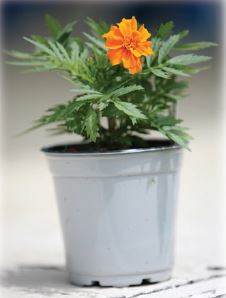
Question 15.
When Bill bought a marigold plant, it was \(\frac{1}{4}\) inch tall. After the first week, it measured 1 \(\frac{1}{12}\) inches tall. After the second week, it was 1 \(\frac{11}{12}\) inches. After week 3, it was 2 \(\frac{3}{4}\) inches tall. Assuming the growth of the plant was constant, what was the height of the plant at the end of week 4?
______ \(\frac{□}{□}\) inches
Answer: 3 \(\frac{7}{12}\) inches
The sequence is the increasing where the first term is \(\frac{1}{4}\)
LCD = 12
First week is \(\frac{3}{12}\)
Second week = \(\frac{13}{12}\) = 1 \(\frac{1}{12}\)
Third week = 1 \(\frac{11}{12}\) = \(\frac{23}{12}\)
Fourth week = \(\frac{33}{12}\) = 2 \(\frac{3}{4}\)
At the end of fourth week = \(\frac{43}{12}\) = 3 \(\frac{7}{12}\) inches
The height of the plant at the end of the week is 3 \(\frac{7}{12}\) inches.
Question 16.
What if Bill’s plant grew at the same rate but was 1 \(\frac{1}{2}\) inches when he bought it? How tall would the plant be after 3 weeks?
______ inches
Answer: 4 inches
Explanation:
The sequence is increasing.
First week 1 \(\frac{1}{2}\)
Let the first term is \(\frac{6}{12}\)
Second term is 1 \(\frac{16}{12}\)
Third term is 1 \(\frac{26}{12}\)
Fourth week is 1 \(\frac{36}{12}\)
1 \(\frac{36}{12}\) = 1 \(\frac{3}{1}\) = 1 + 3 = 4
After 4 weeks the plant grew 4 inches.
Question 17.
Vicki wanted to start jogging. The first time she ran, she ran \(\frac{3}{16}\) mile. The second time, she ran \(\frac{3}{8}\) mile, and the third time, she ran \(\frac{9}{16}\) mile. If she continued this pattern, when was the first time she ran more than 1 mile? Explain.
Type below:
_________
Answer: Sixth time
Explanation:
Vicki wanted to start jogging. The first time she ran, she ran \(\frac{3}{16}\) mile. The second time, she ran \(\frac{3}{8}\) mile, and the third time, she ran \(\frac{9}{16}\) mile.
The difference is \(\frac{3}{16}\)
First time = \(\frac{3}{16}\) mile
Second time = \(\frac{3}{16}\) + \(\frac{3}{16}\) = \(\frac{3}{8}\) mile
Third time = \(\frac{3}{8}\) + \(\frac{3}{16}\) = \(\frac{9}{16}\) mile
Fourth time = \(\frac{9}{16}\) + \(\frac{3}{16}\) = \(\frac{12}{16}\) mile
Fifth time = \(\frac{12}{16}\) + \(\frac{3}{16}\) = \(\frac{15}{16}\) mile
Sixth time = \(\frac{15}{16}\) + \(\frac{3}{16}\) = \(\frac{18}{16}\) mile
\(\frac{18}{16}\) = 1 \(\frac{2}{16}\) = 1 \(\frac{1}{8}\)
Question 18.
Mr. Conners drove 78 \(\frac{1}{3}\) miles on Monday, 77 \(\frac{1}{12}\) miles on Tuesday, and 75 \(\frac{5}{6}\) miles on Wednesday. If he continues this pattern on Thursday and Friday, how many miles will he drive on Friday?
______ \(\frac{□}{□}\) miles
Answer:
Given that,
Mr. Conners drove 78 \(\frac{1}{3}\) miles on Monday, 77 \(\frac{1}{12}\) miles on Tuesday, and 75 \(\frac{5}{6}\) miles on Wednesday.
The sequence is the decreasing where the first term is 78 \(\frac{4}{12}\)
78 \(\frac{4}{12}\) – 77 \(\frac{1}{12}\) = 1 \(\frac{3}{12}\)
The difference between the term is 1 \(\frac{3}{12}\)
On thursday, 75 \(\frac{5}{6}\) – 1 \(\frac{3}{12}\) = 74 \(\frac{7}{12}\)
On friday, 74 \(\frac{7}{12}\) – 1 \(\frac{3}{12}\) = 73 \(\frac{4}{12}\) = 73 \(\frac{1}{3}\)
Question 19.
Test Prep Zack watered his garden with 1 \(\frac{3}{8}\) gallons of water the first week he planted it. He watered it with 1 \(\frac{3}{4}\) gallons the second week, and 2 \(\frac{1}{8}\) gallons the third week. If he continued watering in this pattern, how much water did he use on the fifth week?
Options:
a. 2 \(\frac{1}{2}\) gallons
b. 2 \(\frac{7}{8}\) gallons
c. 3 \(\frac{1}{4}\) gallons
d. 6 \(\frac{7}{8}\) gallons
Answer: 2 \(\frac{7}{8}\) gallons
Explanation:
First term = 1 \(\frac{3}{8}\)
The difference is \(\frac{3}{4}\) – \(\frac{3}{8}\) = \(\frac{3}{8}\)
Second term is 1 \(\frac{3}{8}\) + \(\frac{3}{8}\) = 1 \(\frac{3}{4}\)
Third term = 1 \(\frac{3}{4}\) + \(\frac{3}{8}\) = 1 + 1 \(\frac{1}{8}\) = 2 \(\frac{1}{8}\)
Fourth term = 2 \(\frac{1}{8}\) + \(\frac{3}{8}\) = 2 \(\frac{1}{2}\)
Fifth term = 2 \(\frac{1}{2}\) + \(\frac{3}{8}\) = 2 \(\frac{7}{8}\) gallons
Thus the correct answer is option B.
Share and Show – Page No. 279
Question 1.
Caitlin has 4 \(\frac{3}{4}\) pounds of clay. She uses 1 \(\frac{1}{10}\) pounds to make a cup, and another 2 pounds to make a jar. How many pounds are left?
First, write an equation to model the problem.
Type below:
_________
Answer: 4 \(\frac{3}{4}\) – 1 \(\frac{1}{10}\) – 2
Explanation:
Subtract the total pound of clay from used clay.
So, the equation of the clay leftover is 4 \(\frac{3}{4}\) – 1 \(\frac{1}{10}\) – 2
Question 1.
Next, work backwards and rewrite the equation to find x.
Type below:
_________
Answer: 4 \(\frac{3}{4}\) – 1 \(\frac{1}{10}\) – 2 = x
Explanation:
Let the leftover clay be x
4 \(\frac{3}{4}\) – 1 \(\frac{1}{10}\) – 2 = x
x = 4 \(\frac{3}{4}\) – 1 \(\frac{1}{10}\) – 2
Question 1.
Solve.
_____________________
So, ________ pounds of clay remain.
Type below:
_________
Answer: 1 \(\frac{13}{20}\) pounds
Explanation:
4 \(\frac{3}{4}\) – 1 \(\frac{1}{10}\) – 2
4 + \(\frac{3}{4}\) – 1 – \(\frac{1}{10}\) – 2
4 – 3 = 1
\(\frac{3}{4}\) – \(\frac{1}{10}\) = \(\frac{13}{20}\)
1 + \(\frac{13}{20}\) = 1 \(\frac{13}{20}\) pounds
Question 2.
What if Caitlin had used more than 2 pounds of clay to make a jar? Would the amount remaining have been more or less than your answer to Exercise 1?
Type below:
_________
Answer:
Let us assume that Catlin used 2 \(\frac{1}{4}\) pounds of clay to make a jar and 1 \(\frac{1}{10}\) pounds to make a cup.
4 \(\frac{3}{4}\) – 1 \(\frac{1}{10}\) – 2 \(\frac{1}{4}\) = 2 \(\frac{1}{20}\)
Question 3.
A pet store donated 50 pounds of food for adult dogs, puppies, and cats to an animal shelter. 19 \(\frac{3}{4}\) pounds was adult dog food and 18 \(\frac{7}{8}\) pounds was puppy food. How many pounds of cat food did the pet store donate?
______ \(\frac{□}{□}\) pounds of cat food
Answer: 11 \(\frac{3}{8}\) pounds of cat food
Explanation:
A pet store donated 50 pounds of food for adult dogs, puppies, and cats to an animal shelter.
19 \(\frac{3}{4}\) pounds was adult dog food and 18 \(\frac{7}{8}\) pounds was puppy food.
19 \(\frac{3}{4}\) + 18 \(\frac{7}{8}\) = 38 \(\frac{5}{8}\)
50 – 38 \(\frac{5}{8}\) = 11 \(\frac{3}{8}\) pounds of cat food
Thus the pet store donate 11 \(\frac{3}{8}\) pounds of cat food
Question 4.
Thelma spent \(\frac{1}{6}\) of her weekly allowance on dog toys, \(\frac{1}{4}\) on a dog collar, and \(\frac{1}{3}\) on dog food. What fraction of her weekly allowance is left?
\(\frac{□}{□}\) of her weekly allowance
Answer: \(\frac{1}{4}\)
Explanation:
Given that, Thelma spent \(\frac{1}{6}\) of her weekly allowance on dog toys, \(\frac{1}{4}\) on a dog collar, and \(\frac{1}{3}\) on dog food.
\(\frac{1}{6}\) + \(\frac{1}{4}\) + \(\frac{1}{3}\) = \(\frac{3}{4}\)
1 – \(\frac{3}{4}\) = \(\frac{1}{4}\)
\(\frac{1}{4}\) of her weekly allowance.
On Your Own – Page No. 280
Question 5.
Martin is making a model of a Native American canoe. He has 5 \(\frac{1}{2}\) feet of wood. He uses 2 \(\frac{3}{4}\) feet for the hull and 1 \(\frac{1}{4}\) feet for the paddles and struts. How much wood does he have left?
______ \(\frac{□}{□}\) feet
Answer: 1 \(\frac{1}{2}\) feet
Explanation:
Martin is making a model of a Native American canoe.
He has 5 \(\frac{1}{2}\) feet of wood.
He uses 2 \(\frac{3}{4}\) feet for the hull and 1 \(\frac{1}{4}\) feet for the paddles and struts.
2 \(\frac{3}{4}\) + 1 \(\frac{1}{4}\)
2 + \(\frac{3}{4}\) + 1 + \(\frac{1}{4}\)
2 + 1 = 3
\(\frac{3}{4}\) + \(\frac{1}{4}\) = 1
3 + 1 = 4
5 \(\frac{1}{2}\) – 4 = 1 \(\frac{1}{2}\)
Question 6.
What if Martin makes a hull and two sets of paddles and struts? How much wood does he have left?
Answer: 1 \(\frac{1}{4}\)
Explanation:
He has 5 \(\frac{1}{2}\) feet of wood.
If Martin makes a hull and two sets of paddles and struts
1 \(\frac{1}{4}\) + 1 \(\frac{1}{4}\) = 2 \(\frac{1}{2}\)
2 \(\frac{1}{2}\) + 2 \(\frac{3}{4}\) = 4 \(\frac{1}{4}\)
5 \(\frac{1}{2}\) – 4 \(\frac{1}{4}\)
5 + \(\frac{1}{2}\) – 4 – \(\frac{1}{4}\)
1 + \(\frac{1}{4}\) = 1 \(\frac{1}{4}\)
Question 7.
Beth’s summer vacation lasted 87 days. At the beginning of her vacation, she spent 3 weeks at soccer camp, 5 days at her grandmother’s house, and 13 days visiting Glacier National Park with her parents. How many vacation days remained?
______ days
Answer: 48 days
Explanation:
Given,
Beth’s summer vacation lasted 87 days.
At the beginning of her vacation, she spent 3 weeks at soccer camp, 5 days at her grandmother’s house, and 13 days visiting Glacier National Park with her parents.
87 – 21 – 5 – 13 = 48 days
The remaining vacation days are 48.
Question 8.
You can buy 2 DVDs for the same price you would pay for 3 CDs selling for $13.20 apiece. Explain how you could find the price of 1 DVD.
$ ______
Answer: $19.8
Explanation:
To find what is the price of 1 DVD we will find what is the price of 3 DVDs and then because 2 DVDs price is the same than 3 CDs we can easily find the price of 1 DVD.
$13.20 × 3 = $39.6
We will divide $39.6 by 2.
$39.6 ÷ 2 = $19.8
The price of 1 DVD is $19.8
Question 9.
Test Prep During the 9 hours between 8 A.M. and 5 P.M., Bret spent 5 \(\frac{3}{4}\) hours in class and 1 \(\frac{1}{2}\) hours at band practice. How much time did he spend on other activities?
Options:
a. \(\frac{3}{4}\) hour
b. 1 \(\frac{1}{4}\) hour
c. 1 \(\frac{1}{2}\) hour
d. 1 \(\frac{3}{4}\) hour
Answer: 1 \(\frac{3}{4}\) hour
Explanation:
Test Prep During the 9 hours between 8 A.M. and 5 P.M., Bret spent 5 \(\frac{3}{4}\) hours in class and 1 \(\frac{1}{2}\) hours at band practice.
5 \(\frac{3}{4}\) + 1 \(\frac{1}{2}\) = 7 \(\frac{1}{4}\) hour
9 – 7 \(\frac{1}{4}\) hour
8 + 1 – 7 – \(\frac{1}{4}\)
1 \(\frac{3}{4}\) hour
The correct answer is option D.
Share and Show – Page No. 283
Use the properties and mental math to solve. Write your answer in simplest form.
Question 1.
\(\left(2 \frac{5}{8}+\frac{5}{6}\right)+1 \frac{1}{8}\)
______ \(\frac{□}{□}\)
Answer:
\(\left(2 \frac{5}{8}+\frac{5}{6}\right)+1 \frac{1}{8}\)
2 \(\frac{5}{8}\) + \(\frac{5}{6}\)
2 + \(\frac{5}{8}\) + \(\frac{5}{6}\)
LCD = 24
\(\frac{15}{24}\) + \(\frac{20}{24}\) = \(\frac{35}{24}\)
\(\frac{35}{24}\) = 1 \(\frac{11}{24}\)
2 + 1 \(\frac{11}{24}\) = 3 \(\frac{11}{24}\)
3 \(\frac{11}{24}\) + 1 \(\frac{1}{8}\) = 4 \(\frac{7}{12}\)
Question 2.
\(\frac{5}{12}+\left(\frac{5}{12}+\frac{3}{4}\right)\)
______ \(\frac{□}{□}\)
Answer:
\(\frac{5}{12}+\left(\frac{5}{12}+\frac{3}{4}\right)\)
\(\frac{5}{12}\) + \(\frac{3}{4}\)
LCD = 12
\(\frac{5}{12}\) + \(\frac{3}{4}\) × \(\frac{3}{3}\)
\(\frac{5}{12}\) + \(\frac{9}{12}\) = \(\frac{14}{12}\)
\(\frac{5}{12}\) + \(\frac{14}{12}\) = \(\frac{19}{12}\)
\(\frac{19}{12}\) = 1 \(\frac{7}{12}\)
Question 3.
\(\left(3 \frac{1}{4}+2 \frac{5}{6}\right)+1 \frac{3}{4}\)
______ \(\frac{□}{□}\)
Answer:
\(\left(3 \frac{1}{4}+2 \frac{5}{6}\right)\)
2 + \(\frac{5}{6}\) + 3 + \(\frac{1}{4}\)
2 + 3 = 5
\(\frac{5}{6}\) + \(\frac{1}{4}\)
LCD = 12
\(\frac{5}{6}\) × \(\frac{2}{2}\) + \(\frac{1}{4}\) × \(\frac{3}{3}\)
\(\frac{10}{12}\) + \(\frac{3}{12}\) = \(\frac{13}{12}\) = 1 \(\frac{1}{12}\)
5 + 1 \(\frac{1}{12}\) = 6 \(\frac{1}{12}\)
6 \(\frac{1}{12}\) + 1 \(\frac{3}{4}\)
6 + \(\frac{1}{12}\) + 1 + \(\frac{3}{4}\)
6 + 1 = 7
\(\frac{1}{12}\) + \(\frac{3}{4}\)
\(\frac{1}{12}\) + \(\frac{9}{12}\) = \(\frac{10}{12}\) = \(\frac{5}{6}\)
7 + \(\frac{5}{6}\) = 7 \(\frac{5}{6}\)
On Your Own
Use the properties and mental math to solve. Write your answer in simplest form.
Question 4.
\(\left(\frac{2}{7}+\frac{1}{3}\right)+\frac{2}{3}\)
______ \(\frac{□}{□}\)
Answer:
\(\left(\frac{2}{7}+\frac{1}{3}\right)+\frac{2}{3}\)
\(\left(\frac{2}{7}+\frac{1}{3}\right)\)
LCD = 21
\(\left(\frac{6}{21}+\frac{7}{21}\right)\) = \(\frac{13}{21}\)
\(\frac{13}{21}\) + \(\frac{2}{3}\)
LCD = 21
\(\frac{13}{21}\) + \(\frac{14}{21}\)
\(\frac{27}{21}\) = \(\frac{9}{7}\)
= 1 \(\frac{2}{7}\)
Question 5.
\(\left(\frac{1}{5}+\frac{1}{2}\right)+\frac{2}{5}\)
______ \(\frac{□}{□}\)
Answer:
\(\left(\frac{1}{5}+\frac{1}{2}\right)\)
\(\frac{1}{5}\) + \(\frac{1}{2}\)
LCD = 10
\(\frac{2}{10}\) + \(\frac{5}{10}\) = \(\frac{7}{10}\)
\(\frac{7}{10}\) + \(\frac{2}{5}\)
\(\frac{7}{10}\) + \(\frac{4}{10}\) = \(\frac{11}{10}\)
\(\frac{11}{10}\) = 1 \(\frac{1}{10}\)
Question 6.
\(\left(\frac{1}{6}+\frac{3}{7}\right)+\frac{2}{7}\)
\(\frac{□}{□}\)
Answer:
\(\left(\frac{1}{6}+\frac{3}{7}\right)\)
LCD = 42
\(\left(\frac{7}{42}+\frac{18}{42}\right)\) = \(\frac{25}{42}\)
\(\frac{25}{42}\) + \(\frac{2}{7}\)
LCD = 42
\(\frac{25}{42}\) + \(\frac{12}{42}\) = \(\frac{37}{42}\)
\(\left(\frac{1}{6}+\frac{3}{7}\right)+\frac{2}{7}\) = \(\frac{37}{42}\)
Question 7.
\(\left(2 \frac{5}{12}+4 \frac{1}{4}\right)+\frac{1}{4}\)
______ \(\frac{□}{□}\)
Answer:
\(\left(2 \frac{5}{12}+4 \frac{1}{4}\right)\)
2 \(\frac{5}{12}\) + 4 \(\frac{1}{4}\)
2 + \(\frac{5}{12}\) + 4 + \(\frac{1}{4}\)
2 + 4 = 6
\(\frac{5}{12}\) + \(\frac{1}{4}\) = \(\frac{8}{12}\)
6 \(\frac{8}{12}\) = 6 \(\frac{2}{3}\)
6 \(\frac{2}{3}\) + \(\frac{1}{4}\) = 6 \(\frac{11}{12}\)
Question 8.
\(1 \frac{1}{8}+\left(5 \frac{1}{2}+2 \frac{3}{8}\right)\)
______
Answer:
5 \(\frac{1}{2}\) + 2 \(\frac{3}{8}\)
5 + 2 = 7
\(\frac{1}{2}\) + \(\frac{3}{8}\)
LCD = 8
\(\frac{4}{8}\) + \(\frac{3}{8}\) = \(\frac{7}{8}\)
= 7 \(\frac{7}{8}\)
1 \(\frac{1}{8}\) + 7 \(\frac{7}{8}\) = 9
Question 9.
\(\frac{5}{9}+\left(\frac{1}{9}+\frac{4}{5}\right)\)
______ \(\frac{□}{□}\)
Answer:
\(\frac{1}{9}\) + \(\frac{4}{5}\)
LCD = 45
\(\frac{5}{45}\) + \(\frac{36}{45}\) = \(\frac{41}{45}\)
\(\frac{41}{45}\) + \(\frac{5}{9}\)
LCD = 45
\(\frac{41}{45}\) + \(\frac{25}{45}\) = \(\frac{66}{45}\)
\(\frac{66}{45}\) = 1 \(\frac{7}{15}\)
Problem Solving – Page No. 284
Use the map to solve 10–12.
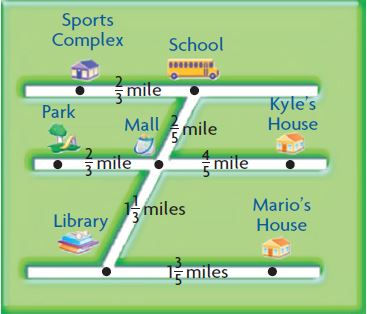
Question 10.
In the morning, Julie rides her bike from the sports complex to the school. In the afternoon, she rides from the school to the mall, and then to Kyle’s house. How far does Julie ride her bike?
______ \(\frac{□}{□}\) miles
Answer: 1 \(\frac{13}{15}\) miles
Explanation:
Julie rides her bike from the sports complex to the school = \(\frac{2}{3}\) mile
In the afternoon, she rides from the school to the mall, and then to Kyle’s house. = \(\frac{2}{5}\) + \(\frac{4}{5}\) = \(\frac{6}{5}\) = 1 \(\frac{1}{5}\)
1 \(\frac{1}{5}\) + \(\frac{2}{3}\) mile = 1 \(\frac{13}{15}\) miles
Question 11.
On one afternoon, Mario walks from his house to the library. That evening, Mario walks from the library to the mall, and then to Kyle’s house. Describe how you can use the properties to find how far Mario walks.
______ \(\frac{□}{□}\) miles
Answer:
Mario walks from his house to the library = 1 \(\frac{3}{5}\) miles
Mario walks from the library to the mall, and then to Kyle’s house = 1 \(\frac{1}{3}\) and \(\frac{4}{5}\)
1 \(\frac{3}{5}\) + (1 \(\frac{1}{3}\) + \(\frac{4}{5}\))
1 \(\frac{3}{5}\) + 2 \(\frac{2}{15}\) = 3 \(\frac{11}{15}\) miles
Question 12.
Pose a Problem Write and solve a new problem that uses the distances between four locations.
Type below:
_________
Answer:
In the evening Kyle rides his bike from the sports complex to school. Then he rides from School to the mall and then to his house. How far does Kyle ride his bike?
The distance from Sports complex to School is \(\frac{2}{3}\) mile
The distance from School to the mall is \(\frac{2}{5}\)
The distance from the mall to Kyle house is \(\frac{4}{5}\)
\(\frac{2}{3}\) + (\(\frac{2}{5}\) + \(\frac{4}{5}\))
\(\frac{2}{3}\) + \(\frac{6}{5}\) = 1 \(\frac{13}{15}\) miles
Question 13.
Test Prep Which property or properties does the problem below use?
\(\frac{1}{9}+\left(\frac{4}{9}+\frac{1}{6}\right)=\left(\frac{1}{9}+\frac{4}{9}\right)+\frac{1}{6}\)
Options:
a. Commutative Property
b. Associative Property
c. Commutative Property and Associative Property
d. Distributive Property
Answer: Associative Property
The associative property states that you can add or multiply regardless of how the numbers are grouped. By ‘grouped’ we mean ‘how you use parenthesis’. In other words, if you are adding or multiplying it does not matter where you put the parenthesis.
Chapter Review/Test – Vocabulary – Page No. 285
Choose the best term from the box.
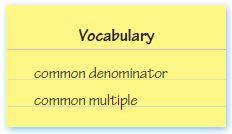
Question 1.
A _________ is a number that is a common multiple of two or more denominators.
_________
Answer: Common Denominator
Concepts and Skills
Use a common denominator to write an equivalent fraction for each fraction.
Question 2.
\(\frac{2}{5}, \frac{1}{8}\)
common denominator: ______
Explain:
_________
Answer: 40
Multiply the denominators of the fractions
5 × 8 = 40
Question 3.
\(\frac{3}{4}, \frac{1}{2}\)
common denominator: ______
Explain:
_________
Answer: 8
Multiply the denominators of the fractions
4 × 2 = 8
Question 4.
\(\frac{2}{3}, \frac{1}{6}\)
common denominator: ______
Explain:
_________
Answer: 18
Multiply the denominators of the fractions
3 × 6 = 18
Find the sum or difference. Write your answer in simplest form
Question 5.
\(\frac{5}{6}+\frac{7}{8}\)
______ \(\frac{□}{□}\)
Answer: 1 \(\frac{17}{24}\)
Explanation:
\(\frac{5}{6}+\frac{7}{8}\) = \(\frac{20}{24}\) + \(\frac{21}{24}\)
= \(\frac{41}{24}\) = 1 \(\frac{17}{24}\)
Question 6.
\(2 \frac{2}{3}-1 \frac{2}{5}\)
______ \(\frac{□}{□}\)
Answer: 1 \(\frac{4}{15}\)
Question 7.
\(7 \frac{3}{4}+3 \frac{7}{20}\)
______ \(\frac{□}{□}\)
Answer: 11 \(\frac{1}{10 }\)
Estimate. Then find the difference and write it in simplest form.
Question 8.
\(1 \frac{2}{5}-\frac{2}{3}\)
Type below:
________
Answer:
Estimate: \(\frac{1}{2}\)
Difference:
Rewriting our equation with parts separated
1 + \(\frac{2}{5}\) – \(\frac{2}{3}\)
\(\frac{7}{5}\) – \(\frac{2}{3}\)
\(\frac{7}{5}\) × \(\frac{3}{3}\) – \(\frac{2}{3}\) × \(\frac{5}{5}\)
= \(\frac{21}{15}\) – \(\frac{10}{15}\)
= \(\frac{11}{15}\)
Question 9.
\(7-\frac{3}{7}\)
Type below:
________
Answer: 6 \(\frac{4}{7}\)
Explanation:
\(7-\frac{3}{7}\) = \(\frac{49}{7}\) – \(\frac{3}{7}\)
\(\frac{46}{7}\) = 6 \(\frac{4}{7}\)
\(7-\frac{3}{7}\) = 6 \(\frac{4}{7}\)
Question 10.
\(5 \frac{1}{9}-3 \frac{5}{6}\)
Type below:
________
Answer: 1 \(\frac{5}{18}\)
Explanation:
\(5 \frac{1}{9}-3 \frac{5}{6}\) = 5 + \(\frac{1}{9}\) – 3 – \(\frac{5}{6}\)
5 – 3 = 2
\(\frac{1}{9}\) – \(\frac{5}{6}\) = \(\frac{2}{18}\) – \(\frac{15}{18}\) = – \(\frac{13}{18}\)
2 – \(\frac{13}{18}\) = 1 \(\frac{5}{18}\)
Use the properties and mental math to solve. Write your answer in simplest form.
Question 11.
\(\left(\frac{3}{8}+\frac{2}{3}\right)+\frac{1}{3}\)
______ \(\frac{□}{□}\)
Answer: 1 \(\frac{3}{8}\)
Explanation:
\(\frac{3}{8}\) + \(\frac{2}{3}\) = \(\frac{9}{24}\) + \(\frac{16}{24}\) = \(\frac{25}{24}\)
\(\frac{25}{24}\) + \(\frac{1}{3}\)
= \(\frac{25}{24}\) + \(\frac{8}{24}\) = \(\frac{33}{24}\) = \(\frac{11}{8}\)
The mixed fraction of \(\frac{11}{8}\) is 1 \(\frac{3}{8}\).
Question 12.
\(1 \frac{4}{5}+\left(2 \frac{3}{20}+\frac{3}{5}\right)\)
______ \(\frac{□}{□}\)
Answer: 4 \(\frac{11}{20}\)
Explanation:
Rewriting our equation with parts separated
2 \(\frac{3}{20}\) + \(\frac{3}{5}\) = \(\frac{43}{20}\) + \(\frac{3}{5}\)
\(\frac{43}{20}\) + \(\frac{3}{5}\) = \(\frac{215}{100}\) + \(\frac{60}{100}\)
= \(\frac{275}{100}\) = 2 \(\frac{3}{4}\)
2 \(\frac{3}{4}\) + 1 \(\frac{4}{5}\) = 2 + \(\frac{3}{4}\) + 1 + \(\frac{4}{5}\)
2 + 1 = 3
\(\frac{3}{4}\) + \(\frac{4}{5}\) = \(\frac{15}{20}\) + \(\frac{16}{20}\) = \(\frac{31}{20}\)
\(\frac{31}{20}\) = 4 \(\frac{11}{20}\)
Question 13.
\(3 \frac{5}{9}+\left(1 \frac{7}{9}+2 \frac{5}{12}\right)\)
______ \(\frac{□}{□}\)
Answer: 7 \(\frac{3}{4}\)
Explanation:
1 \(\frac{7}{9}\) + 2 \(\frac{5}{12}\)
1 + 2 = 3
\(\frac{7}{9}\) + \(\frac{5}{12}\)
LCD is 36
\(\frac{28}{36}\) + \(\frac{15}{36}\) = \(\frac{43}{36}\)
\(\frac{43}{36}\) = 1 \(\frac{7}{36}\)
3 + 1 + \(\frac{7}{36}\) = 4 \(\frac{7}{36}\)
4 \(\frac{7}{36}\) + 3 \(\frac{5}{9}\)
4 + \(\frac{7}{36}\) + 3 + \(\frac{5}{9}\)
4 + 3 = 7
\(\frac{7}{36}\) + \(\frac{5}{9}\)
= \(\frac{7}{36}\) + \(\frac{20}{36}\) = \(\frac{27}{36}\) = \(\frac{3}{4}\)
7 + \(\frac{3}{4}\) = 7 \(\frac{3}{4}\)
Chapter Review/Test – Page No. 286
Question 14.
Ursula mixed 3 \(\frac{1}{8}\) cups of dry ingredients with 1 \(\frac{2}{5}\) cups of liquid ingredients. Which answer represents the best estimate of the total amount of ingredients Ursula mixed?
Options:
a. about 4 cups
b. about 4 \(\frac{1}{2}\) cups
c. about 5 cups
d. about 5 \(\frac{1}{2}\) cups
Answer: about 4 \(\frac{1}{2}\) cups
Explanation:
Ursula mixed 3 \(\frac{1}{8}\) cups of dry ingredients with 1 \(\frac{2}{5}\) cups of liquid ingredients.
3 + 1 = 4
\(\frac{1}{8}\) is closer to 0.
\(\frac{2}{5}\) is closer to \(\frac{1}{2}\)
4 + \(\frac{1}{2}\) = 4 \(\frac{1}{2}\)
Thus the correct answer is option B.
Question 15.
Samuel walks in the Labor Day parade. He walks 3 \(\frac{1}{4}\) miles along the parade route and 2 \(\frac{5}{6}\) miles home. How many miles does Samuel walk?
Options:
a. \(\frac{5}{10}\) mile
b. 5 \(\frac{1}{12}\) miles
c. 5 \(\frac{11}{12}\) miles
d. 6 \(\frac{1}{12}\) miles
Answer: 6 \(\frac{1}{12}\) miles
Explanation:
Samuel walks in the Labor Day parade.
He walks 3 \(\frac{1}{4}\) miles along the parade route and 2 \(\frac{5}{6}\) miles home.
3 + \(\frac{1}{4}\) + 2 + \(\frac{5}{6}\)
3 + 2 =5
\(\frac{5}{6}\) + \(\frac{1}{4}\) = \(\frac{10}{12}\) + \(\frac{3}{12}\) = \(\frac{13}{12}\)
\(\frac{13}{12}\) = 6 \(\frac{1}{12}\) miles
Thus the correct answer is option D.
Question 16.
A gardener has a container with 6 \(\frac{1}{5}\) ounces of liquid plant fertilizer. On Sunday, the gardener uses 2 \(\frac{1}{2}\) ounces on a flower garden. How many ounces of liquid plant fertilizer are left?
Options:
a. 3 \(\frac{7}{10}\) ounces
b. 5 \(\frac{7}{10}\) ounces
c. 6 \(\frac{7}{10}\) ounces
d. 9 \(\frac{7}{10}\) ounces
Answer: 9 \(\frac{7}{10}\) ounces
Explanation:
A gardener has a container with 6 \(\frac{1}{5}\) ounces of liquid plant fertilizer.
On Sunday, the gardener uses 2 \(\frac{1}{2}\) ounces on a flower garden.
6 + \(\frac{1}{5}\) + 2 + \(\frac{1}{2}\)
6 + 2 = 8
\(\frac{1}{5}\) + \(\frac{1}{2}\)
LCD = 10
\(\frac{2}{10}\) + \(\frac{5}{10}\) = \(\frac{7}{10}\)
8 \(\frac{7}{10}\)
Question 17.
Aaron is practicing for a triathlon. On Sunday, he bikes 12 \(\frac{5}{8}\) miles and swims 5 \(\frac{2}{3}\) miles. On Monday, he runs 6 \(\frac{3}{8}\) miles. How many total miles does Aaron cover on the two days?
Options:
a. 23 \(\frac{1}{6}\) miles
b. 24 \(\frac{7}{12}\) miles
c. 24 \(\frac{2}{3}\) miles
d. 25 \(\frac{7}{12}\) miles
Answer: 24 \(\frac{2}{3}\) miles
Explanation:
Aaron is practicing for a triathlon.
On Sunday, he bikes 12 \(\frac{5}{8}\) miles and swims 5 \(\frac{2}{3}\) miles.
On Monday, he runs 6 \(\frac{3}{8}\) miles.
5 \(\frac{2}{3}\) + 6 \(\frac{3}{8}\) = 12 \(\frac{1}{24}\)
12 \(\frac{1}{24}\) + 12 \(\frac{5}{8}\) miles
12 + \(\frac{1}{24}\) + 12 + \(\frac{5}{8}\)
12 + 12 = 24
\(\frac{1}{24}\) + \(\frac{5}{8}\) = \(\frac{1}{24}\) + \(\frac{15}{24}\) = \(\frac{16}{24}\) = \(\frac{2}{3}\)
24 + \(\frac{2}{3}\) = 24 \(\frac{2}{3}\) mile
The correct answer is option D.
Chapter Review/Test – Page No. 287
Fill in the bubble completely to show your answer.
Question 18.
Mrs. Friedmon baked a walnut cake for her class. The pictures below show how much cake she brought to school and how much she had left at the end of the day.

Which fraction represents the difference between the amounts of cake Mrs. Friedmon had before school and after school?
Options:
a. \(\frac{5}{8}\)
b. 1 \(\frac{1}{2}\)
c. 1 \(\frac{5}{8}\)
d. 2 \(\frac{1}{2}\)
Answer: 1 \(\frac{5}{8}\)
Explanation:
The fraction for the above figure is 1 \(\frac{7}{8}\)
The fraction for the second figure is \(\frac{1}{4}\)
1 + \(\frac{7}{8}\) – \(\frac{1}{4}\)
\(\frac{7}{8}\) – \(\frac{1}{4}\) = \(\frac{7}{8}\) – \(\frac{2}{8}\)
\(\frac{7}{8}\) – \(\frac{2}{8}\) = \(\frac{5}{8}\)
1 + \(\frac{5}{8}\) = 1 \(\frac{5}{8}\)
The correct answer is option C.
Question 19.
Cody is designing a pattern for a wood floor. The length of the pieces of wood are 1 \(\frac{1}{2}\) inches, 1 \(\frac{13}{16}\) inches, and 2 \(\frac{1}{8}\) inches. What is the length of the 5th piece of wood if the pattern continues?
Options:
a. 2 \(\frac{7}{6}\) inches
b. 2 \(\frac{3}{4}\) inches
c. 3 \(\frac{1}{2}\) inches
d. 4 inches
Answer: 2 \(\frac{3}{4}\) inches
Explanation:
The length of the pieces of wood are 1 \(\frac{1}{2}\) inches, 1 \(\frac{13}{16}\) inches, and 2 \(\frac{1}{8}\) inches
1 \(\frac{1}{2}\) = \(\frac{3}{2}\)
1 \(\frac{13}{16}\) inches = \(\frac{29}{16}\)
\(\frac{29}{16}\) – \(\frac{3}{2}\) = latex]\frac{5}{16}[/latex]
5th piece = \(\frac{3}{2}\) + latex]\frac{5}{16}[/latex] (5 – 1)
= \(\frac{3}{2}\) + latex]\frac{5}{16}[/latex] 4
= \(\frac{3}{2}\) + latex]\frac{20}{16}[/latex]
= \(\frac{3}{2}\) × latex]\frac{8}{8}[/latex] + latex]\frac{20}{16}[/latex]
= latex]\frac{44}{16}[/latex] = 2 latex]\frac{3}{4}[/latex]
Thus the correct answer is option B.
Question 20.
Julie spends \(\frac{3}{4}\) hour studying on Monday and \(\frac{1}{6}\) hour studying on Tuesday. How many hours does Julie study on those two days?
Options:
a. \(\frac{1}{3}\) hour
b. \(\frac{2}{5}\) hour
c. \(\frac{5}{6}\) hour
d. \(\frac{11}{12}\) hour
Answer: \(\frac{11}{12}\) hour
Explanation:
Julie spends \(\frac{3}{4}\) hour studying on Monday and \(\frac{1}{6}\) hour studying on Tuesday.
\(\frac{3}{4}\) + \(\frac{1}{6}\)
LCD = 12
\(\frac{9}{12}\) + \(\frac{2}{12}\) = \(\frac{11}{12}\) hour
So, the correct answer is option D.
Chapter Review/Test – Page No. 288
Constructed Response
Question 21.
A class uses 8 \(\frac{5}{6}\) sheets of white paper and 3 \(\frac{1}{12}\) sheets of red paper for a project. How much more white paper is used than red paper? Show your work using words, pictures, or numbers. Explain how you know your answer is reasonable.
______ \(\frac{□}{□}\) sheet of white paper
Answer: 5 \(\frac{3}{4}\) sheet of white paper
Explanation:
A class uses 8 \(\frac{5}{6}\) sheets of white paper and 3 \(\frac{1}{12}\) sheets of red paper for a project.
8 \(\frac{5}{6}\) – 3 \(\frac{1}{12}\)
8 + \(\frac{5}{6}\) – 3 – \(\frac{1}{12}\)
8 – 3 = 5
\(\frac{5}{6}\) – \(\frac{1}{12}\)
\(\frac{10}{12}\) – \(\frac{1}{12}\) = \(\frac{9}{12}\)
\(\frac{9}{12}\) = \(\frac{3}{4}\)
5 + \(\frac{3}{4}\) = 5 \(\frac{3}{4}\)
Performance Task
Question 22.
For a family gathering, Marcos uses the recipe below to make a lemon-lime punch.
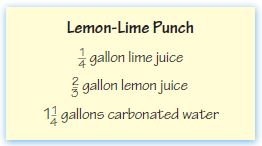
A). How would you decide the size of a container you need for one batch of the Lemon-Lime Punch?
Type below:
________
Answer: He may use \(\frac{1}{4}\) gallon lime juice for one batch of the lemon-lime punch.
Question 22.
B). If Marcos needs to make two batches of the recipe, how much of each ingredient will he need? How many gallons of punch will he have? Show your math solution and explain your thinking when you solve both questions.
Type below:
________
Answer: \(\frac{2}{3}\) gallon lime juice
Question 22.
C). Marcos had 1 \(\frac{1}{3}\) gallons of punch left over. He poured all of it into several containers for family members to take home. Use fractional parts of a gallon to suggest a way he could have shared the punch in three different-sized containers.
Type below:
________
Answer: 1 \(\frac{1}{12}\)
Conclusion
Answering the concepts in Go Math Grade 5 Chapter 6 Solution Key helps students to attempt the exam with confidence and prepare accordingly. Once you get to know the concept better you can solve any kind of question framed on Addition and Subtraction of Fractions with Unlike Denominators. Check your knowledge by taking an Assessment Test on Chapter 6 available.
